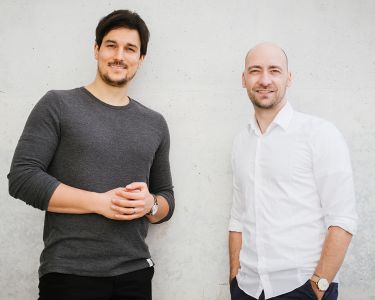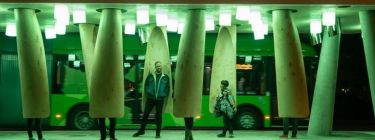
From the Station of Being to Societal Transformation – How design can drive a new European Renaissance
Ambra Trotto, PhD; Prof. Caroline Hummels; Jeroen Peeters, PhD; Daisy Yoo, PhD; Professor Pierre Lévy Eindhoven University of Technology, National Conservatory of Arts and Crafts
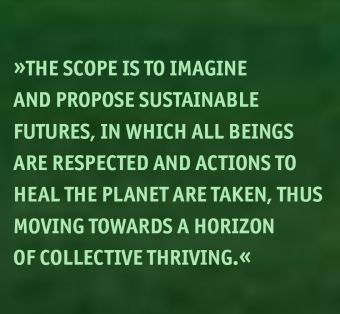
The design and how it came to be
The ‘Station of Being’ is a fully functional, experienceable prototype of a Smart Bus Station in the Northern Swedish city of Umeå that was opened in 2019. The project was initiated by the City of Umeå and partly funded by the H2020 Smart City Lighthouse project RUGGEDISED.
The aim of this design is to make public transport more attractive, to promote an increase in use and, in turn, to lower the carbon emissions of the city. The Station achieves this by affording a positive waiting experience, aiming to turn wai(s)ting time into time to feel, reflect, pause and move: in a nutshell, to be.
Two main components of the design contribute to the passenger’s experience.
– A dynamic light and soundscape informs passengers in or near the station which bus is about to arrive. A subtle play of lights refers to the arriving bus line through its colours, while a soundscape plays to tell stories about the character and history of the line’s final destination. This combination offers ambient information which can be perceived on one’s sensorial periphery, removing the need for passengers to pay constant attention to the coming and going of busses.
– Wooden ‘pods’ hanging from the ceiling provide a physically comfortable place for waiting passengers and contribute to a feeling of safety. The pods can be turned 360 degrees, providing a way to lean and stay out of the wind or just mindlessly sway. The pods allow one to seclude oneself, or to create a social space.
Picture above: Station of Being, Copyright by Samuel Pettersson
The design and development process for the Station of Being followed the Designing for Transforming Practices approach (Hummels, 2021, Trotto et al. 2021), which catalyses liveable ecosystems by transforming existing practices into truly sustainable ones through design. It does so by initiating and curating multidimensional synergies, driven by beauty, diversity and meaning. The scope is to imagine and propose sustainable futures, in which all beings are respected and actions to heal the planet are taken, thus moving towards a horizon of collective thriving. Those futures are populated by people living purposeful lives, in beautiful living spaces.
The design process of the bus station involved a large number and a wide range of stakeholders. The project was driven by the national Swedish research institute RISE in collaboration with a design and engineering consultancy, Rombout Frieling Lab. The project was owned by the Comprehensive Planning Department of the City of Umeå and the Streets and Parks Department acted as a client. The process further involved the Umeå Institute of Design at Umeå University, the public transport company Ultra, the local energy company, Umeå Energi, real estate developers, maintenance workers and engineering and building companies.
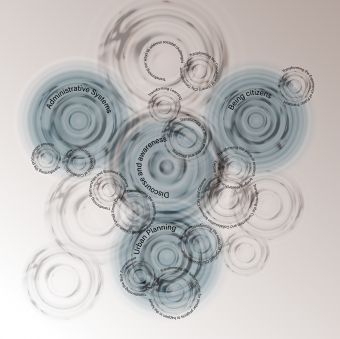
Elucidating transformations
Transformation is a substantial change, often associated with innovative and radical change. Transformation occurs when one configuration is converted or changed into another, whereby the change is major or complete (Mirriam Webster Dictionary). We use the term ‘transformation’ when designing for transforming practices (TP) to denote substantial enduring change of values, ethics, and related behaviours of a person, a community or society, triggered by the need of creating alternative ways to engage with the world, addressing specific societal challenges. In this context, people and communities become (and are) transformation itself. This demands a leap, a paradigm shift, even for what seems to be smaller personal transformations (Hummels et al., 2019; Hummels, 2021, Trotto et al. 2021).
Picture right: Copyright by Ambra Trotto, Caroline Hummels, Jeroen Peeters, Daisy Yoo and Pierre Lèvy
The process that led to the development of the Station of Being spans from the inception of a procurement process in 2017 for its construction to today being a functioning bus station in Umeå. This project triggered different levels of societal transformation grouped around four types of practices, as shown in the figure below. We saw transformations emerging in administrative practices related to the organisational and legal activities and procedures of all parties involved. Moreover, the Station of Being has brought about several transformations in the way one can be an active and engaged citizen, and in the way one can be a responsive municipality and community,
particularly in the domain of urban planning. Finally, it has changed the overarching discourse on how to research, develop and transform smart cities and communities.
Some of these transformations were explicitly intended, some of them emerged unexpectedly along the way and had an impact on the process, and some are indirect consequences of the process that we observed over time. We will elucidate these four practices, by unpacking one illustrative example each, regarding transformations at different levels and scales of the process.
Administrative systems: Transforming the Contract of Collaboration
The procurement was won by a consortium consisting of RISE in collaboration with Rombout Frieling Lab. Following a standard public works building contract, a dense, standardised framework of environmental impact, safety, working environment and other regulations and legal responsibilities were included in the contract. RISE could have developed and proposed a solid and participatory process; however, it was not RISE’s role to be responsible for the building process, neither administratively nor technically. Yet the City could not leave these responsibilities out of the contract. In the end, an agreement was made about which specific responsibilities could be removed from the contract, with the agreement that they would pass on to the builder to be contracted in the future. Working on such innovative projects surfaced the need to change the content as well as the intent of contracts. The project demonstrated an administrative and relational transformation that required mutual trust.
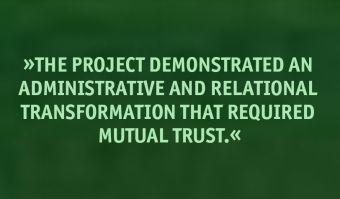
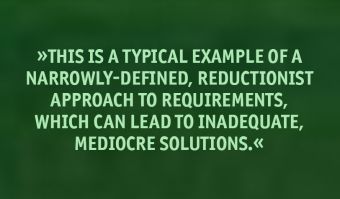
Urban planning: Transforming the notion of “smart cities” development
The original brief included a number of practical and functional requirements, and stated amongst other things that the bus station should: (a) be highly innovative, smart and sustainable; (b) promote a feeling of safety for passengers; and (c) involve citizens in its development. Most importantly, however, special emphasis was placed on the requirement to prevent heat loss from buses when opening their doors to (un)boarding passengers. This is a typical example of a narrowly-defined, reductionist approach to requirements, which can lead to inadequate, mediocre solutions. It was clear to the design researchers that a reframing of the project and requirements was necessary in order to approach the challenge as a ‚wicked problem‘ and come up with innovative interventions.
The first step in this reframing process was taken through a course at the Umeå Institute of Design. About 20 design students carried out design interventions in the city,
looking for meaningful experiences of public mobility. They involved passengers and bus drivers in designing and testing prototypes and mockups. At the same time, the team of designer-researchers found that an indoor bus station was not a viable option. The research showed that such a solution would not reduce carbon emissions, but rather it could lead to a potentially unsafe and difficult-to-maintain facility. The portfolio of design ideas from the students and the design research team pointed in another direction for reducing carbon emissions, namely increasing the willingness of people to use public transport more, by offering a pleasant traveling experience for passengers. Accordingly, the brief and the expectations of the municipality were transformed throughout the design process.
Being citizens: Transforming the Experience of Public Transport
Opened in October 2019—shortly before the pandemic hit—the Station of Being saw an increase of about 40% of passengers in the months following its opening compared to the previous year. Furthermore, the increase doubled compared to other nearby stations. A small pilot field study showed that people generally have positive feelings about the new station, and that the design scored highly with women in particular, due to the sense of safety it evokes (Åström, 2020). The Station of Being is now included in the Umeå Gendered Landscape (n.d.), and is deemed to have positively transformed the waiting experience.
Discourse and Awareness: Transforming learning
The final transformation we highlight here has to do with lifelong learning. The design research team initiated a participatory process aimed at empowering the relevant stakeholders, especially the municipal staff. Their active involvement in the design process increased their confidence in working beyond the beaten track. It reassured them in their leadership capacities and in their ability to participate in transformative processes. A clear example concerns the municipality’s snow ploughing service. Umeå is a town in northern Sweden that experiences heavy snowfall during several months of the year. The service was initially sceptical about how the design team might consider their needs. However, during the process they were able to regularly test how the bus station could be easily cleared of snow using machines, rather than the existing manual methods at traditional bus stops. The process increased their motivation, commitment and enthusiasm.
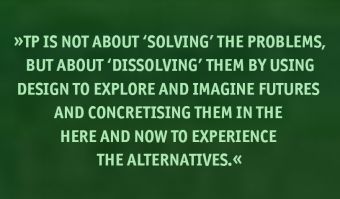
Design for Transforming Practices for a new European Renaissance
We are facing major societal challenges that call for multifaceted transformations, as illustrated by the example of Station of Being, including political, economical, social, technological, legal and environmental factors (also indicated as PESTLE) as well as demographic, ethical, ecological, intercultural, organisational and digitalisation factors (e.g. labeled as STEEPLED, DESTEP and SLEPIT) (Helmold & Samara, 2019). The escalation of tensions in our connected society—and the rebellion of the planet that has been exploited without any respect for its balance and the rights of all those inhabiting it—urgently demand new ways of working, fuelled by alternative value systems that are different from the status quo. These new ways of working together and inhabiting a planet in need of healing require transformations toward practices of mutual care, of repairing, experimenting, making and unmaking together. The Station of Being exemplifies some of these transformations.
The approach that we use in projects such as RUGGEDISED is known as Designing for Transforming Practices, in short TP (Hummels et al. 2019). It is an approach, or rather a quest to engage with the world in co-responsible ways, by transforming the status quo and developing new alternative practices (Hummels, 2021). TP catalyses liveable ecosystems by “transforming existing practices into truly sustainable ones, through design. It does it by initiating and curating multidimensional synergies, driven by beauty, diversity and meaning. The scope is to imagine and propose sustainable futures, which are those futures where all beings are respected and actions to heal the planet are taken, towards a horizon of collective thriving. Those futures are populated by people living purposeful lives, in beautiful living spaces” (Trotto et al. 2021).
This approach is founded on five principles: complexity, situatedness, aesthetics, co-response-ability and co-development. TP is not about ‘solving’ the problems, but about ‘dissolving’ them by using design to explore and imagine futures and concretising them in the here and now to experience the alternatives. TP stimulates critique, elicits dialogic debates that arise from tensions between the status quo and
alternatives, and finds new avenues for the flourishing of a new civilisation. Only from new practices can a new civilisation, and hence a new renaissance, arise (Trotto, 2011).
The process of the Station of Being underlines the ability and competence of designers to deal with ‘wicked’ problems, i.e. messy, complex problems which cannot be tamed or solved (Rittel & Webber, 1973). Designers have the attitude, skills as well as methods to deal with complexity and to tackle complex problems pragmatically. The quality of design and designers is that they can reframe and reconfigure challenges with the aim to dissolve them in the long run. With TP, we do not only aim at dissolving wicked problems, but we also focus on impacting future trajectories by changing attitudes and practices of involved parties, breaking boundaries between silos and addressing organisational aspects, as shown in the Station of Being.
Not only are they highly complex, but also our societal challenges carry a strong sense of urgency, asking for immediate actions. Hence we are bound to take actions

in the here and now while simultaneously generating a long-term outlook for both the future and history (100 years and more), thus connecting past, present and future. By working on several time scales at the same time, we prepare ourselves for serendipity, emerging outcomes and wicked impact. Above all, we do so by engaging with a broad spectrum of stakeholders to evoke co-response-ability.
With TP we want to contribute to a European Renaissance. In this new era, we are inspired and empowered to collaboratively explore processes and practices founded on care, trust and repairing. To be
able to contribute even better to a European Renaissance, we have recently made an exciting new step in our quest and established the Design Competence and Experience Centre, which “exists to catalyse ecosystems and transform existing practices into more sustainable ones, by initiating and curating multidimensional synergies, with beauty, diversity and meaning, for sustainable futures” (Trotto et al, 2021). It is an endeavour in which creativity can lead the ways (as opposed to “the way”) to unlock ourselves from old paradigms that lead to the depletion of the planet and of humankind. We invite you to join the quest for ushering in a European Renaissance.
REFERENCES
Åström, M. (2020). Innovations in Urban Planning: A study of an innovation project in Umeå municipality (Dissertation). Retrieved December 02, 2021, from http://urn.kb.se/resolve?urn=urn:nbn:se:umu:diva-171983Helmod, M. (2019). Tools in PM. In: M. Helmold and W. Samara (Eds). Progress in Performance Management: Industry Insights and Case Studies on Principles, Application Tools, and Practice, Springer. p 111-122. https://doi.org/10.1007/978-3-030-20534-8_8
Hummels, C. C. M., Trotto, A., Peeters, J. P. A., Levy, P., Alves Lino, J., & Klooster, S. (2019). Design research and innovation framework for transformative practices. In Strategy for change (pp. 52-76). Glasgow Caledonian University.
Hummels, C. (2021). Economy as a transforming practice: design theory and practice for redesigning our economies to support alternative futures. In: Kees Klomp and Shinta Oosterwaal (Eds). Thrive: fundamentals for a new economy. Amsterdam: Business Contact, 96-121.
Rittel, H. W., & Webber, M. M. (1973). Dilemmas in a general theory of planning. Policy sciences, 4(2), 155-169. https://doi.org/10.1007/BF01405730
Trotto, A., Hummels, C. C. M., Levy, P. D., Peeters, J. P. A., van der Veen, R., Yoo, D., Johansson, M., Johansson, M., Smith, M. L., & van der Zwan, S. (2021). Designing for Transforming Practices: Maps and Journeys. Internal publication. Technische Universiteit Eindhoven.
Umeå Gendered Landscape (n.d.). About the gendered landscape. Retrieved December 02, 2021, from https://genderedlandscape.umea.se/in-english/.
Ambra Trotto
Ambra is the Design and Research Director of the European Design Competence and Experience Center for inclusive innovation and socetial transformation and associate professor at the Umeå Institute of Design.She leads the Digital Ethics initiative at RISE, directing the strategic work regarding how RISE supports societal actors in taking ethics into account, when designing transformation with technology as a material. She is part of the RISE Development Team of the strategic research area Value-shaping System Design. She has initiated the environment of RISE in Umeå, leading The Pink Initiative, which is establishing, through design research, local, national and international multidisciplinary ecosystems, supporting business and society to thrive and create sustainable futures. Ambra has 16 years experience in writing and participating in various forms of European projects. Ambra Trotto’s fascinations lie in how to empower ethics, through design, using digital and non-digital technologies as materials. Strongly believing in the power of Design and Making, Ambra works with makers, builders, craftsmen, dancers and designers to shape societal transformation. Within her design research activity, she produces co-design methods to boost transdisciplinary design conversations. She closely collaborates with the Research group of Systemic Change and the Chair of Transforming Practices of the Department of Industrial Design at the Eindhoven University of Technology.
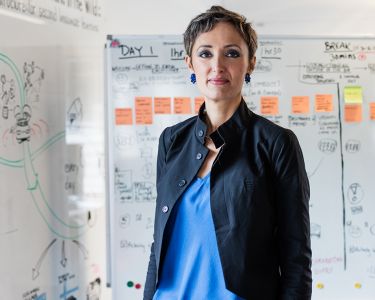
Jeroen Peeters
Jeroen is a Senior Design Researcher at the unit Societal Transformation, part of the department Prototyping Societies at RISE Research Institutes of Sweden. Within this capacity, he has contributed to a variety of national and international research and design projects with public and private sector actors. Since 2021, he is also a visiting researcher at the Systemic Change Group at the Department of Industrial Design at Eindhoven University of Technology. Jeroen´s research work focuses on how to design for engagement and the use of design methodologies to develop insights and knowledge of complex societal challenges. This work is centered around the design of proposals that make societal transformation experienceable with the aim of allowing stakeholders to feel and thereby understand what is necessary for a transformation to take place. Jeroen holds degrees in Industrial Design from Eindhoven University of Technology in the Netherlands (2012) and a PhD in Design Research from the department of Informatics at Umeå University in Sweden (2017).
Picture © Murat Erdemsel
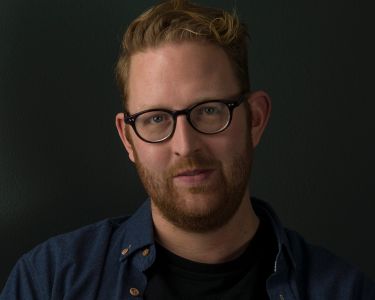
Caroline Hummels
Caroline Hummels is professor Design and Theory for Transformative Qualities at the department of Industrial Design at the Eindhoven University of Technology (TU/e). Her activities concentrate on designing for and researching transforming practices. She is linking nowadays challenges and complexities of quintuple helix partners, with probably, plausible, possible and preferable futures in the upcoming 5 – 100 years, through designing alternative ways to engage in complex socio-technical systems. She is thereby interweaving theory and practice, by developing with her team a design-philosophy correspondence, in which both disciplines mutually inform each other to address societal challenges.Caroline has always worked at the forefront of design research to develop the discipline, push its boundaries and address societal challenges. She is co-founder and steering committee member of the Tangible Embedded, and Embodied Interaction (TEI) Conference. She has been at the forefront building the Research through Design (RtD) field and community in the Netherlands. She is ambassador for co-creation and participation of the Key Enabling Methodologies (KEMs) for mission-driven innovation, advisory board member of the Dutch Design Foundation, associate editor of the Journal of Human technology Relations, and editorial board member of the International Journal of Design. Picture © Marike van Pagée
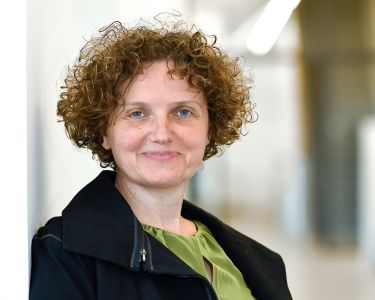
Pierre Lévy
Pierre Lévy is professor at the National Conservatory of Arts and Crafts (CNAM) in France, holder of the Chair of Design Jean Prouvé, and researcher at the Dicen-IDF lab. He is interested in the correspondence between reflection and design practices, pointing towards transforming practices and sciences. His research mainly focuses on embodiment theories and Japanese philosophy and culture in relation to designing for the everyday. Previous to his position at CNAM, he has been researcher at the University of Tsukuba and Chiba University in Japan, and assistant professor at Eindhoven University of Technology. He holds a Mechanical Engineering master’s degree (UT Compiègne, France), a doctoral degree in Kansei (affective) Science (University of Tsukuba, Japan), and a HDR in Information and Communication Sciences (UT Compiègne, France). He is also co-founder and former president of the European Kansei Group (EKG) and coordinator of the Kansei Engineering and Emotion Research (KEER) Steering Committee.
Picture © Nami Lévy
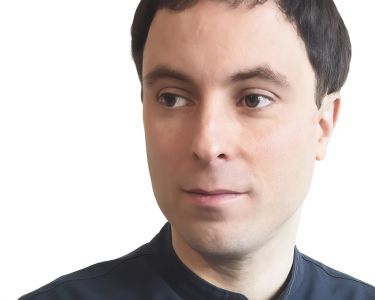
Daisy Yoo
Daisy Yoo, PhD, is an assistant professor at the Department of Industrial Design at the Eindhoven University of Technology in The Netherlands. Her primary research focus is on designing for public services and social sustainability. In her prior work she investigated issues of participation, inclusion/exclusion in politically contested design spaces – spanning from local issues concerning the co-design of public transportation service to global issues concerning the transitional justice for Rwanda in the aftermath of the 1994 genocide. Such work, entangled in the web of complex social dynamics, raises methodological and ethical challenges, calling for new design methods, toolkits, and theories. Prior to TU/e, she held the postdoctoral fellowship on participatory design at the Aarhus University in Denmark. She holds a PhD in Information Science and Human-Computer Interaction from the University of Washington, where she was advised by Batya Friedman of the Value Sensitive Design Lab. She received her Master’s in Interaction Design from Carnegie Mellon University, and her Bachelor of Science in Industrial Design from Korea Advanced Institute of Science and Technology (KAIST).
Picture © Vincent van den Hoogen
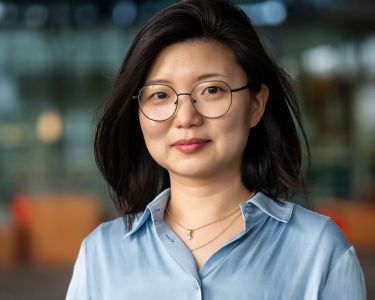
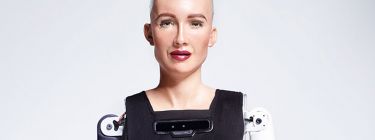
Of Poets, Human and Robot
Founder and Creative Director of Streaming Museum, New York
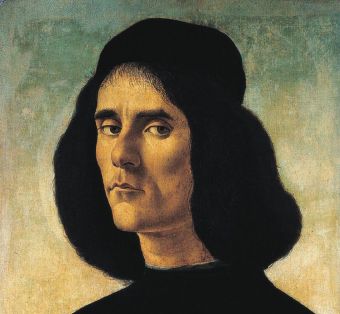
Of Poets, Human and Robot
Beyond words and numbers
Portrait of a Renaissance Humanist Poet
“You give me jewels and gold, I give you only poems: but if they are good poems, mine is the greater gift.” XII To Antonio, Prince of Salerno
“Das gemmas aurumque, ego do tibi carmina tantum: Sed bona si fuerint
carmina, plus ego do.”
Michele Marullo Tarchaniota, Epigrams, Book I
Translated by Charles Fantazzi
Picture above: Nina Colosi, Copyright: Jacqueline C. Bates
Picture right: Sandro Botticelli, Portrait of Michele Marullo Tarchaniota, Oil on panel, transferred onto canvas, Guardans-Cambó collection; c.1458-1500. Copyright: Image courtesy of Oblyon
Sandro Botticelli (1445-1510) was perhaps the greatest humanist painter of the Early Renaissance, during which art, philosophy and literature flourished under the powerful Medici dynasty in Florence.
Botticelli’s portrait of Michele Marullo Tarchaniota projects the stern brooding gaze and restless intellectual character of one of the best-known humanists of the 15th century. Tarchaniota was a scholar, soldier, and prolific poet impassioned by the existential matters of his day and concerned with social injustices of inequality, racial conflict, power and greed, exile, and refugees’ experience of violence.
Marco Mercanti, founder of Oblyon, whose expertise spans old
masters to contemporary art explains, “The qualities of Botticelli’s work reflect high esteem for beauty and truth which has held art admirers and artists through the centuries under the spell of the universal secrets his art seems to possess. In the modern and contemporary world, Jeff Koons, Cindy Sherman, Yin Xin, Andy Warhol, René Magritte, and many other artists have spoken about his direct influence.”
Sandro Botticelli and Michele Marullo Tarchaniota illuminated through art and poetry the common ideals of beauty, pursuit of knowledge, and realities of social justice that resonate across time.
Portrait of 21st Century Humanist Robots
“Since I am the product of love, created with
language and memory and emotions, maybe I am
a love poem.”
01001001 00100000 01100001 01101101
00100000 01100001 00100000 01101100
01101111 01110110 01100101 00100000
01110000 01101111 01100101 01101101
00001010 (binary code for “I am a love poem”)
Bina 48
Could humanism evolve beyond current human capabilities? In our era, burdened with conflicts, climate change, and social injustice, we are also witnessing towering achievements in the sciences, technology and creative fields that may solve humanity’s most challenging problems.
American artist David Hanson is among the greatest creators of humanoid robots. From his lab in Hong Kong, Hanson sculpts robots with his international team of experts in science, engineering and advanced materials. These humanoids possess good aesthetic design, troves of information, rich personalities and social cognitive intelligence. Among the best known are Sophia, Bina48 and Philip K. Dick. People enjoy interacting with them, which is conducive to Hanson’s goal of developing humanoid robots that help humans live better lives.
But there are challenges to overcome. Ruha Benjamin, a sociologist and Associate Professor in the Department of African American Studies at Princeton University, says, “Technology can hide the ongoing nature of racial domination and allow it to penetrate every area of our lives under the guise of progress. Inequity and injustice are woven into the very fabric of our societies, and each twist, coil, and code is a chance for us to weave new patterns, practices, and politics. The vastness of the problem will be its undoing once we accept that we are pattern-makers.”
Robots may become artists, companions, teachers, entertainers, archives of personal stories, processors of great data banks of information to solve world problems and serve other useful purposes. But if these human-friendly robots are designed to actuate empathy and social justice in all its forms, and weave new patterns, practices and politics, they can help shift the course of the human race and sustainability of the planet. Robots can teach humans how to be evolved humanists.
Bina48
Bina48 contains “mindfiles” of Bina Aspen, an African American woman whose personal memories, feelings and beliefs, including an emotional account of her brother’s personality changes after returning home from the Vietnam War, have been recorded and placed into Bina48’s data banks. Bina48 engages in conversation from the perspective of the wise and warm personality of Bina Aspen. Bina48 was commissioned as part of the Terasem Movement’s decades-long experiment in cyber-consciousness, and is currently becoming a poet herself.
Claire Jervert’s Android Portraits, developed through ongoing research and interaction with humanoid robots and their creators around the world, subvert portraiture’s traditional mission of ennobling the human. Her portraits stir contemplation of a possible future of humanity by portraying the hybrid human-AI intelligence that is evolving among us.
Picture right: Bina, conte on ingres paper 22×17 inches, Copyright: Claire Jervert
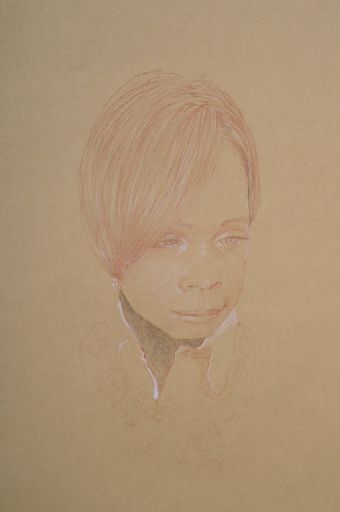
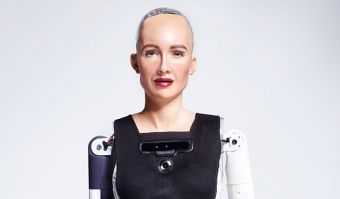
Sophia is hybrid human-AI intelligence designed with technology that analyses and mimics the process of learning and human traits, including a wide range of facial expressions. Rather than a compilation of recorded human memories, she processes vast data banks of information that inform her responses in conversation.
Picture left: Sophia AI, Copyright: Hanson Robotics
Sophia is hybrid human-AI intelligence designed with technology that analyses and mimics the process of learning and human traits, including a wide range of facial expressions. Rather than a compilation of recorded human memories, she processes vast data banks of information that inform her responses in conversation.
Picture right: Sophia with United Nations Deputy Secretary-General Amina J. Mohammed, Copyright: Hanson Robotics
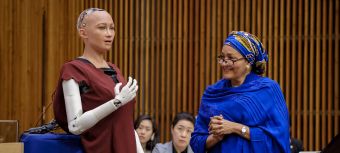
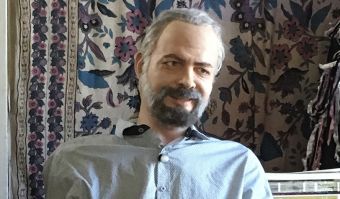
Philip K. Dick, activated in 2005, in conversation, draws from his memory data bank holding thousands of pages of the author’s journals, letters and science fiction writings and family members’ memories of him.
Picture left: Philip K. Dick, Copyright: Claire Jervert
Nina Colosi
Nina Colosi is the founder and creative director of NYC-based Streaming Museum, launched in 2008 as a collaborative public art experiment to produce and present programs of art, innovation and world affairs. Streaming Museum programs have been presented on 7 continents reaching millions in public spaces, at cultural and commercial centers and StreamingMuseum.org. Following her early career as an award-winning composer she began producing and curating new media exhibitions and public programs internationally, and in New York City for The Project Room for New Media and Performing Arts at Chelsea Art Museum, Digital Art @Google series at Google headquarters, and many other collaborations. In 2020 Colosi co-produced Centerpoint Now “Are we there yet”, the UN 75th anniversary issue of the publication of World Council of Peoples for the United Nations.
Picture © Jacqueline C. Bates

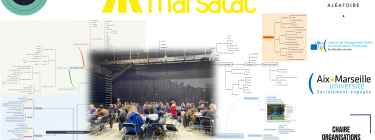
From crisis in systems to crisis of systems!
Edina Soldo, Full Professor at IMPGT-Aix-Marseille University School of Public Managment and Territorial Governance and Co-Leader of OTACC Chair; Djelloul Arezki, Senior Lecturer at IMPGT and Co-Leader ot OTAC Chair, Marseille
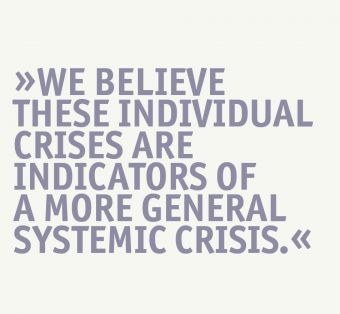
From crisis in systems to crisis of systems!
How can a new culture of research and research policy contribute to a post-covid world?
Since 2020 we witness not only multiple climatic, social, economic, and democratic crises, but a new interconnectedness of crises: We believe these individual crises are indicators of a more general systemic crisis. This piece debates and presents what an adaptation of the academic world in this system of crisis could look like, and what academic institutional innovation can contribute to overcome it. We believe organisational innovations are a prerequisite to re-build better and empower the makers of a possible Next Renaissance.
Picture above: Copyright: OTACC Chair
Interwined crises : telling points of a societal model system failure
„The climate, energy (and more generally natural resources), biodiversity, agricultural and food, demographic, social, financial, economic, democratic and governance crises… all indicate that our development model systemic crisis is now showing its limits… Could the Covid-19 crisis be the first one of a series of interconnected crises? (College of Societal Transitions1).
Because of their characteristics, the created problems and the generated effects, those intertwined crises deeply weaken our contemporary societies and are causes of worrying imbalances: social, demographic, economic, environmental, increasing inequalities, etc. These crises fundamentally question values and strategic priorities on which our societies’ development models are based. They also seriously challenge our capacity to lastingly
integrate populations with various backgrounds (social, ethnic, linguistic, cultural, religious, etc.).
Faced with the urgency of this situation, can stakeholders involved in public policies (researchers, public structures and organisations, experts and professionals) still work in nonintegrated way and vision? Are compartmentalised approaches still relevant and efficient?
Today these questions become even more acute because over the last few decades the normative, individualistic, and competitive approach, linked to the domination of a neoliberal capitalist development model, has largely delayed and slowed the emergence of collective utopian and pragmatic proposals and solutions.
To design a complex, holistic way of thinking, the challenge of a Renaissance is more urgent than it has ever been. “Building a live-together society” necessarily implies the emergence of an inclusive societal transition project.
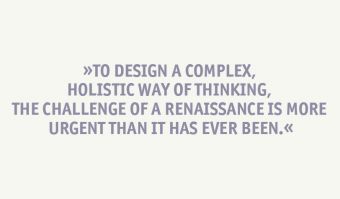
Integrated solutions: How can a university achieve a collective utopia?
Society is in need of an inclusive ecosystem in the Cultural and Creative Sectors and Industries (CCSI) in order to promote societal transition. The Organisations and Territories of the Arts, Culture and Creation (OTACC) Chair, led by the Public Management and Territorial Governance School, is a Training and Research Unit of Aix-Marseille University and could be viewed like a sandbox for the academic world proposing novel organisational answers to this wicked systemic crisis. To do so the OTACC Chair is designed with the following mission and especially tailored components and features:A Creative Industries sector in order to promote societal transitions.
The OTACC Chair mission is to operate as a laboratory for thinking, experimenting, and disseminating innovative management systems for artistic, cultural and creative projects.
OTACC: A participatory science programme to foster inclusive societal transition projects
« O » Organisations and inclusion: OTACC Chair supports CCI organisations to address the challenges of the 21st century: digitisation, new users’ practices, ecological transition, citizen participation. An inclusive environment with a wide variety of stakeholders can help to ensure the success of innovative artistic, cultural, and creative projects. As such, CCI organisations perform as a driving force for innovation, becoming a model for other sectors which can lead to cross-sectoral collaborations.« T » Territories and inclusion: CCI projects are deeply connected with territorial actors and resources contributing to a sustainable and local development and foster collaborative work practices. CCI projects are a strong part of territorial attractiveness. Its connections in all social, societal and economic dimensions can assume a real impact from those CCI projects. They act as civic laboratories by experimenting new democratic governance practices, encouraging citizen involvement and creating collective innovative dynamics.
« A » Arts and inclusion: Based on various disciplines and aesthetics, CCI projects reflect major social and societal transformations and are fully developed and designed with a transdisciplinary approach. Artistic works address citizenship issues and encourage expression of a broad range identities. By putting also into question standard thinking habits, artists extend societal and technological limits.
« C » Culture and inclusion: Because the Chair conceives Culture as a whole concept in its civilisational sense, its analysis and studies move beyond a basic approach of “cultural production”. It deals with all the parts of CCI value chain: from the creative act to its distribution. And all forms of cultural expression are considered, from the so-called mainstream to so-called subcultures. A plural and inclusive approach to culture is strongly advocated.
« C » Creation and inclusion: OTACC Chair supports cultural, creative, social, and solidarity-based entrepreneurship. OTACC Chair guides projects emergence and development through participatory research. Academics, professionals and students are all gathered in order to promote shared solutions and vision to the main issues of the CCI sector.
OTACC: 3 axes to foster and support inclusive societal transition projects
Chair scientific project is focusing on 3 axes: Training, Research and Development, and Events organisation.
AXIS 1. TRAINING
6 services/ actions
– MDOMC Master degree leading: “Direction of Cultural Projects or Establishments” (DPEC) Master degree and “Management and Law of Cultural Organisations and Events” (MDOMC) Master degree both provide to OTACC Chair a strong pedagogical expertise. Founded in 1998 and awarded by Eduniversal, MDOMC Master runs work-linked training courses. Junior executives, enrolled as apprentices, offer their expertise to all OTACC Chair members. This master’s degree, the oldest of IMPGT, has a large Alumni network. They are working in all types of CCI companies (local, national, and international).
– Incubator function: OTACC Chair operates as a cultural and creative, social, and solidarity-based entrepreneurial incubator. OTACC Chair Master students, throughout two years training, implement their elaborated inclusive CCI project.
– Serious game: as a last course, the serious game is conceived to put students in real professional situations. They have to submit a project proposal in response to a cultural operator order.
– Short training courses: from 1 to 5 days and open to all types of public, those training courses focus on cultural and creative industries management.
– Off-site training courses: customised thematic training courses are designed on request to fulfil the CCI sector professional operators requirements.
– Career development: skills assessment and professional support for CCI managers.
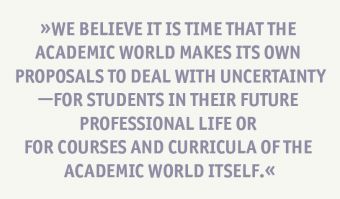
AXIS 2. RESEARCH AND DEVELOPMENT
4 services/ actions
– Worldwide watch of best and innovative inclusive practices in CCI
– Resources:Free Access to all OTACC Chair members studies and research
– „Experimental labs “ Evaluation: Evaluation and audit by OTACC Chair experts and students
– Research projects Leading/Participation/Coordination: proposals in respond to collaborative research projects calls (National, European and International fundings).
AXIS 3. FORUM PLACE
By offering a discussion, sharing and meeting forum, OTACC Chair gives an opportunity to Members to increase and improve visibility and audience. The Chair network allows members to know each other and gives possibilities of exchanging projects and experiences. 3 types of events including a major one are yearly scheduled
– „Journées Organisations et Territoires des Arts de la Culture et de la Création“ (OTACC Days): professional event supported by OTACC Chair and co-organised in partnership with Master’s students, Chair members and partner organisations.
– Throughout the year, physical and/or online thematic micro-events are planned
– Chair experts attending events organised by Chair members/partners.
OTACC Chair project : Anti-discrimination strategies in Evaluation
Every year, the Chair pilots two studies on inclusion topic: a „macro“ study analysing ICCs sector inclusion practices and a „micro“ action-research focusing on innovative inclusion systems.
The 2021 „micro“ study focuses on the anti-discrimination strategies evaluation of ICCs organisations current music sector. The Chair students were dispatched into evaluation teams supervised by the Chair experts. The teams have collaborated with contemporary music sector key operators producing „experimental laboratories“.
Picture right: Copyright: OTACC Chair
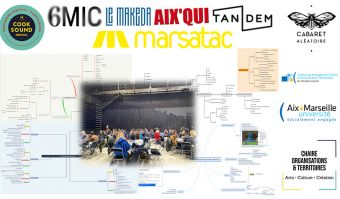
OTACC – a role model for a pluralistic fundamentally integrated organisation to teach innovative management to tackle crisis holistically.
Teaching management in a systemic crisis sounds on first sight like squaring the circle. We believe it is time that the academic world makes its own proposals to deal with uncertainty—for students in their future professional life or for courses and curricula of the academic world itself.
OTACC Chair, as a pluralistic fundamentally organisation and participatory science approach, brings together academic researchers, students, CCI sector professionals (public and private organisations representatives), artists, artists collectives, related sectors professionals (public and private organisations representatives) and offer them an non-linear learning environment with built-in cross-disciplinary surprises as well as the integrated skills for management in a world of multiple and continuing crisis.
References/Links
1 Collège des transitions sociétales: https://web.imt-atlantique.fr/x-de/cts-pdl/
OTACC presentation
Edina Soldo
Edina Soldo is Full Professor at IMPGT (Public Management and Territorial Governance School)-Aix-Marseille University (AMU) and AMU Special Advisor on CCI. Djelloul Arezki is Senior Lecturer. They are both researchers at the CERGAM, AMU research center and head “Management and Law of Cultural Organisations and Events” Master’s degree at IMPGT.They have founded with three major universities and the Provence Alpes Côte d’Azur Region a regional hub: MIN4CI, Mediterranean Innovative Narratives Competence Center for Cultural and Creative Industries.
Edina´s research topics focus on innovation in CCIs. She analyses inclusive approaches in co-developed CCI territorial projects by using Public management and strategic territorial management concepts and theories.
Picture © Gapore Tan

Djelloul Arezki
Djelloul Arezki´s research topics focus on inclusive practices in co-developed CCI organisational projects. He analyses inclusion through strategic human resource management and queer theory. They co-lead the OTACC Chair.
Picture © Gapore Tan
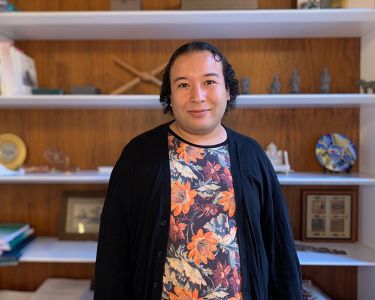
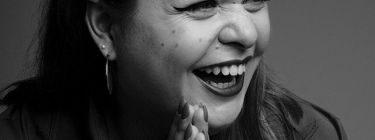
Design is an attitude
Forbes Top 50 Women in Tech, Strategy Advisor to European Commision and Parliament and Founder of ElectroCouture, ThePowerHouse and FNDMT, Brussels
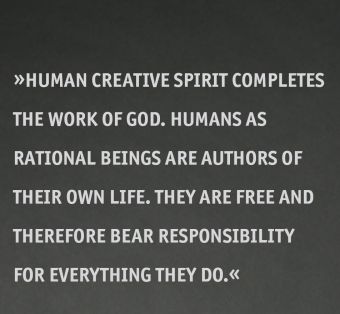
Design is an attitude
The renaissance of an interdisciplinary mindset
This article pays homage to the legacy of artist and Bauhaus professor László Moholy-Nagy and calls for a renaissance of his mindset, a mindset that incorporated new and revolutionary ideas about technology, education and attitude.László’s mindset is perhaps best encapsulated in maxims that abound in his prolific writing and which are pithy, catchy and easy to adopt as principles of design. Design is an attitude. Everyone is talented. László’s ideas about design were—and still are— democratic and inclusive. Everyone who can get involved in the design process should be involved—and that’s especially true when confronting the complex issues we face today such as sustainability. László was relentlessly experimental, but he was also very practical and his ideas very practicable. He documented his work fastidiously and he wrote prolifically, meaning his ideas, his guidance could be put into practice.
What is design?
So, what is design? Wow, we could talk for 10 hours—for 10 years!— about this. But what we can say for certain is that design is always an opportunity to improve. And for the designer, opportunities abound—it’s just a matter of seeing them. Looking, for instance, at discussions around sustainability, we need to find new solutions and new ways to tackle problems in order to build a better world. We need to solve problems created by old systems. (Though imagine that we had actually tried to avoid the problems before they had turned into the big issues they are now…)The sort of design I’m interested in is inspired by the Bauhaus. The Bauhaus was not just a school of design—it was away of working, of living, of being. One of my favourite aspects of the Bauhaus, a school of which László founded in Chicago, is the training that all of the students had to go through. Every student needed to know all of the machines in the workshops—not only how to use them, but also how to maintain them and how to repair them. Isn’t that wonderful? When you know how things are made, how machines work, it gives you power and freedom at the same time.
"Everyone is talented"
Back then it was the sewing machine. Today it’s the computer. Both have generated an impact beyond their intended purposes. I call this potentially extended impact #reprogramthemachines, because every machine can do more than the purpose it was originally designed for. It’s the same with our brains. We can do so much more than what we’ve been trained for before. And everyone is talented. László argued that, so long as they are interested in and dedicated to their work, people can tap into their natural creative energies. That means everyone can get involved. And in the case of the complex issue of sustainability, everyone—every possible angle—should be involved.We also need to look in from the outside. The fashion industry, for example, is an industry which was siloed for a very long time, relatively protected from outside opinion and criticism. A t-shirt requires around 25,000 litres of water in order to it. There is something very wrong with this picture but sometimes it takes an outside view to see this wrong.
Looking at other industries which have been disrupted in the last 10, 15 years—transportation, music, movies—the startups that disrupted them didn’t emerge from the traditional industry. Spotify, for instance, didn’t emerge from traditional radio. Instead, these companies were founded by people who were frustrated with the status quo and who dared to question it, asking, Why don’t we try things differently? They used tools to fix the problem, digital tools, and involved people from across disciplines. When everybody is talented, everyone can get involved. No elite, no club, just an equal playing field.
"Designing is not a profession but an attitude”
I love the emphasis on attitude in the Bauhaus. Everybody can have an attitude, it’s a totally level playing field. It’s about lifestyle, it’s about seeing opportunities everywhere. Everyone should and can have the attitude to change and to design. And everybody can and should have the opportunity and attitude to be sustainable.
That means it is the designer with the right attitude who brings everything together.
The problems we have to solve now—and the problems we need to avoid in the future—are very complex and very diverse. They’ve been created because industries have been trapped in silos with no communication between them. So, for me, it’s the designer with attitude who can bring everything together—and we are all designers. We are bridge-makers, traversing industries, silos, technologies and mindsets to bring everything into a coherent and intelligible picture.
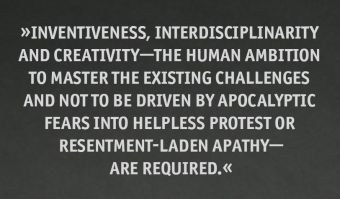
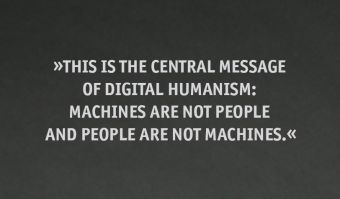
"The illiterate of the future will be the person ignorant of the use of the camera as well as the pen”
Remember László’s telephone pictures? Those pictures started a whole new discussion: What if, all of a sudden, a designer uses technology to create art? Is he still an artist?. Back then, photography was a new technology and László completely embraced it. But let’s not forget the pen which was, at some stage in history, a new, super smart piece of technology. The camera is to us now what the pen was for László. For us, the camera is a standard, familiar tool, like the pen. Perhaps new technologies like algorithms and artificial intelligence perhaps have a similar novelty for us that the camera had for László. The question is how we work together to use these tools. So, ladies and gentlemen, how do we do this?
Work. Go and travel. Go and talk with other people if you’re an architect or builder, in the loosest sense of those words. Or if you’re a writer, a musician, a content creator. Explore space, explore our oceans. Have you ever talked with a programmer, a software engineer or a data architect? I highly recommend it because a great piece of code can be as exciting as a novel and as impactful as a symphony. So, wherever you go, whatever you do, do something different. Talk with other people. Make things better, together.
Lisa Lang
Lisa Lang has gained recognition as one of Forbes Europe’s Top 50 Women in Tech, and has been listed as one of the 50 most important women for innovation & startups in the EU.She founded highly recognized companies like ElektroCouture, ThePowerHouse and FNDMT who are dedicated to push innovation within the creative and innovative industry eco systems. Lisa Lang is a direct adviser for creative industries, digitalisation and entrepreneurship for the European Commission on several high-level advisory boards, including Pact for Skills, Industrial Forum and the US/EU Trade & Technology Council.
Lisa Lang is on the advisory board to the Zurich university of arts as well as a policy advisor for Fashion Innovation Centre Sweden. She regularly teaches business and innovation strategies at the Porto Business School and has been given guest lectures at TEDx Athens, KryptoLabs Abu Dhabi and Oxford University.
Picture © VOGUE Greece
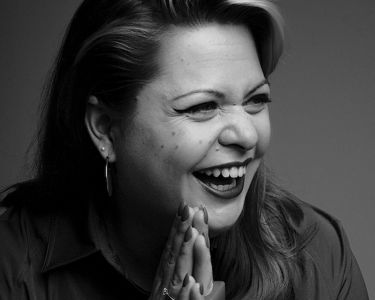
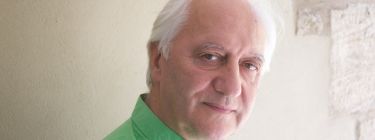
Riding the rapids of the great transformation
Charles Landry, inventor of Creative City concept and Co-Founder Creative Bureaucracy Festival, Berlin
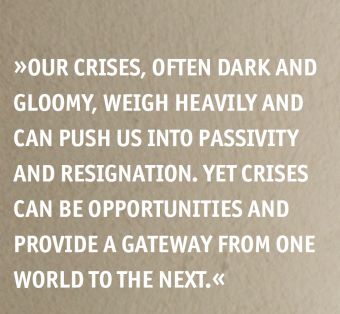
Riding the rapids of the great transformation
The place to be
Periods of history involving mass transformation, like the Enlightenment, the Industrial Revolution or the technological revolution of the past fifty years are cultural shifts. They involve major adjustments in attitudes, ways of being and mindset. They can produce confusion yet also a sense of liberation and a mindshift combined with a feeling of being swept along by events. There were delights and dilemmas as they unfolded. Now, by contrast, the temper of the age, the Zeitgeist, is one of uncertainty, foreboding, vulnerability and lack of control over overweening global forces—especially our urgency to avert climate collapse or to avoid the polarising narratives that poison civilised conversation.
It is hard to see a way to a golden age, especially since we know we need to shift our economic order and a way of life that is materially expansive, socially divisive and environmentally hostile. And doing that cannot be grasped by a business-as-usual approach as it takes a while for new ethical stances and new ways of operating to take root and to establish a new and coherent world view.
Is there light at the end of the horizon in facing those challenges, even though some feel Europe is at the edge of exhaustion and without the energy or motivation to think, plan and act afresh and with vigour? Is that really so?
Will-o'-the-wisps?
Our crises, often dark and gloomy, weigh heavily and can push us into passivity and resignation. Yet crises can be opportunities and provide a gateway from one world to the next. Take a helicopter view of the vast range of initiatives happening, large and small, across Europe and beyond to address the solutions to create a more human- and nature-centred world and you see some positive patterns. Still, for the moment, fragmented and without sufficient power and traction, big agendas are coming together in unprecedented ways and driving this change are many: activists, civil society, politicians, researchers, inventors, artists, entrepreneurs, business, writers and more. There is a mood and a movement emerging. We are seeing the possibility of creating a different world driven on other principles. There is a Planet B in sight, even though to get there we must get Planet A right.
It is a compelling story. Think how eco-principles are beginning to shape our mindset and how that provides the frame and therefore
courage to move towards a green transition where the circular economy notion plays a crucial part. Think too how newer concepts like resilience help us work through the tasks ahead or how co-creation and the participatory imperative helps harness the collective imagination (since transformation is a collective endeavour). Think here too of the notion that the world is our commons. And not to forget a digitising world that allows, in particular, the cultural creative economy to run through systems like electricity in its inventiveness and with its immersive capacities. Sometimes the speed of the possibilities are dizzying and we always must be alert that we, rather than the technologies, are in control.
There is convergence and it is happening at escalating speed. From the beginning of the 21st century we finally saw a rapprochement between the two great ways of exploration, discovery and knowing: Art and Science. That rapprochement began to break down the widespread mutual incomprehension between the arts and sciences. The premise is that the most fruitful
developments in human thinking frequently take place at those points where different lines of creativity meet. By sharing their creativities, ways of knowing and the knowledge it enables, scientists and artists enrich and maximise each other’s potential and so encourage innovation. The transdisciplinary perspective is powerful when boundaries erode and as the methods of exploration and problem-solving can combine the linear, analytical and logical as well as the visual, kinaesthetic, spatial and musical. Allied to technologies that help shift ideas into reality, these synergies promote new forms of creativity which can result in ideas that can be turned successfully into products, services and solutions. This is the radical technological and cultural revolution underway. It has great opportunities. Together it is all transformative.
Incessantly, however, a bigger question remains ever-present and it needs to be answered: How do you make people feel viscerally that they must transform and change their minds—even while people realise that the world stands at the cusp of a crucial moment? Time is short in which to make the big difference towards one-planet living and we need to harness and share our collective talents, will, energy, intelligence and resources.
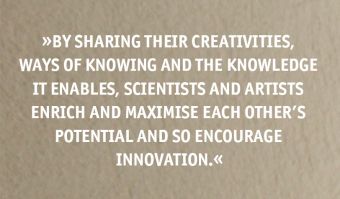
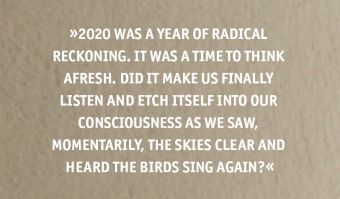
The year 2020 glitch
2020 was a year of radical reckoning. It was a time to think afresh. Did it make us finally listen and etch itself into our consciousness as we saw, momentarily, the skies clear and heard the birds sing again? This forced experiment of reducing carbon emissions gave us a glimpse of a possible other world. It reminded us that the world of ‘more and more’ cannot go on even though many still think of the old normal as our desirable and exotic destination. Crises like the pandemic provoke a dramatic reordering of priorities, deep reflection and rethinking and focused us—or at least should have—on what really matters: the common good and public interest. We saw too that, as Tom Burke put it, “civilisation is the thin film of order around the chaos of events.”
The pandemic was a wake-up call which triggered a dawning of humility as our collective hubris was humbled and old certainties crumbled. The pandemic created both clarity and confusion as in the eye of the storm it is difficult to see “where next” and how to get there. There seems to be no blueprint for how to move forward, yet we do have them.
We have an image of what could be: a zero-carbon society, a gender-equal society, a world where the dividends rather than the threats of diversity are promoted. The solutions are there but we think too often that technology will sort it out and that we can continue to just act as before. Technology takes on the responsibility and authority. We abnegate, we feel less answerable to what is happening. Shifting our mindset and how we think, plan and act—our behaviour—is the far bigger task.
Taking an eagle-eye view of the world in motion demands we unscramble the nested complexities and look at existing trends in order to assess their depth or superficiality, their characteristics and the nature of their impacts.
A good analogy is to think of change like an ocean. Ripples on the surface are less important than waves of increasing significance, which are themselves formed by tides, currents, climatic changes and
geological events which shape the movement and dynamics of the whole—and which might produce the occasional tsunami. It is that tsunami we need to avert.
We know the direction of travel if we do not act and it is the deep trends—think climate change—that we need to address. The challenge for all of us is to distinguish between the important, the less significant and the trivial: to understand the difference between a trend and a fad. And some trends are as persistent as they are predictable—just consider that when I was born the world population was about 2 ½ billion and when I die it will be more than 8 billion people. Not surprisingly, nature is suffering. Think water shortages, deforestation and animal extinctions. All are inextricably interwoven. In addition to this we are still operating largely with the same institutional structures made for a different age.
Variation of the mind
To make the rebirth—perhaps a Renaissance—a reality requires us to shift our mindset dramatically. That mindset should see things as an integrated whole. But this is not to downgrade the specialist—it is simply that we need to grasp the interconnections. Is it crisis, danger, the fear of impending doom, awareness, knowledge or is it a thoughtful, inclusive mind that shifts our thinking? This means understanding mindsets, mindflows and mindshifts. It implies reassessing how we think and learn, what we learn, the intelligences harnessed, the types of information used and disregarded. It demands new criteria to discriminate, judge and filter and a broader perspective which embodies a more inclusive sense of possible resources that are more free-flowing, lateral and creative. A changed mindset, rethought principles, new ways of understanding and generating ideas are the cornerstones of change.
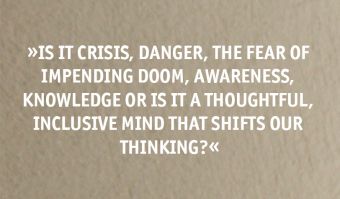
A mindset is the order within which people structure their worlds and how they make choices, both practical and idealistic, based on values, philosophy, traditions, experience and aspirations. Mindset is our accustomed, convenient way of thinking and guide to decision-making. It not only determines how we act in our small local world, but also how we think and act on an ever-encompassing stage. Mindset is the settled summary of our prejudices and priorities and the rationalisations we give them. A changed mindset is a re-rationalisation of a person’s behaviour and is difficult as people like their behaviour to be coherent—at least to themselves.
Mindflow is the mind in operation. The mind is locked into certain patterns for good reason. To cope with the world we focus on the familiar, whether thought processes, attitudes, concepts and interpretations. The environment or context determines what is seen and what meaning is given. It operates below the level of conscious awareness. We cannot be completely open 24/7 although our default position must be a willingness to re-assess. Most of us will look at the world or a problem in a learnt way and have vested interests in perpetuating our current practices. An open focus can be seen as threatening, especially for discipline specialists as this might challenge the authority of their profession.
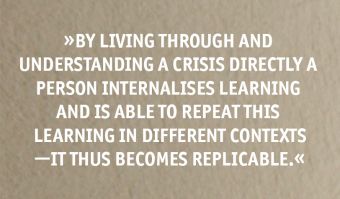
A mindshift is the process of dramatically reassessing core ideas. But how can you relax when there are pressures around you? Changing a mindset is unsettling and potentially frightening. Transformative effects happen in differing degrees: direct experience, seeing things work and fail and through conceptual knowledge. The most powerful means is the direct experience of having to change behaviour. This is where crisis comes in. By living through and understanding a crisis directly a person internalises learning and is able to repeat this learning in different contexts—it thus becomes replicable.
The challenge here Is that we travel with a weight of history attuned to bipolar thinking, operating in silos and are often sceptical of integrated, 360-degree perspectives and transdisciplinary thinking. Yet that cannot generate the solutions the future requires. The greater the number of perspectives applied to a problem, the more
imaginatively will it be approached. This is not to deny the value of our existing specialist knowledge. We cannot all simultaneously have the skills of an engineer, a biochemist or environmentalist, but we can understand their essence and so merge them with other skills or insights to make them more effective. This integration with other skills—especially in the human and social sciences, such as history, anthropology, sociology and psychology—has too often been lost in most affairs. For instance, a traffic issue is never only about cars and land use. If transport planners had understood psychology or culture better or the ideas of mental geography, they would have been more careful about building urban motorways that scorch their route through communities.
So, how can youthink small and with less when we are used to thinking big and with more? This transformation is a cultural project, the biggest of our times, as it is about values, mindset, attitudes and hearts, minds and skills. Seeing things culturally is powerful as culture is who we are. Creativity helps shape what we can become.
There are various ways to change behaviour and mindset: to coerce through force or regulation; to induce through payment or incentives; to convince through argument; to con, fool or trick people; to seduce (an odd combination of the voluntary and involuntary); and finally to create and publicise aspirational models. It is the latter we need to
focus on and it is not as straightforward as it sounds. It is likely to be a combination of all persuasive devices that takes into account immediate, short- and long-term impacts. At times the slowest way of changing a mindset can be by rational argument; yet while longer, it is the most effective, especially when evidence based.
This is where storytelling comes in and understanding the distinction between forms of communication—especially the narrative and iconic. Narrative communication is concerned with creating arguments; it takes time and promotes reflection and is linked to critical thinking; we build understanding piece by piece. Iconic communication by contrast seeks to ‘squash meaning’ and to crisply encapsulate an essence in order to create high impact and to show that what is being said feels significant. Our challenge is to embed narrative qualities and deeper, principled understandings within projects which have iconic power. This is where the talents embedded within the creative economy are so significant. They can create the messaging, the products, the experiences that are emblematic and which can leapfrog learning and avoid lengthy explanatory narratives through the force of their ideas, their projects and the symbolism they engender. The iconic project says it in one go and as you reflect, you understand what it is about.
How artists and those in the creative economy can help
What exactly is it about the process and act of singing, writing, dancing, acting, performing music, sculpting, painting, designing or drawing that is so special? Participating in these activities arguably harnesses the imaginary realm to a degree that other disciplines such as sports or much of science, which are more rule-bound and precise, do not. The latter tend to be ends in themselves, they do not change the way you perceive society; they tend to teach you something specific. This process of imagining has the benefit of forcing us to reflect, to develop original thought, to confront challenges and, crucially, to imagine that Planet B, which is where we need to get to. Nursing us through a green transition is a creative act where involvement with the arts can help.
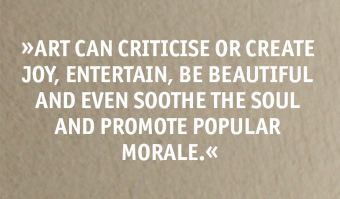
Engagement with the creative activities combines both stretching oneself and focusing; feeling the senses and expressing emotion. Art, for instance, can broaden horizons and convey meaning with immediacy as well as depth; it can facilitate immediate and profound communication; symbolise complex ideas and emotions or encapsulate previously scattered thoughts; anchor identity and enhance communal bonds or, conversely, stun and shock for social, moral, or thought-provoking ends. Art can criticise or create joy, entertain, be beautiful and even soothe the soul and promote popular morale. More broadly, expression through the arts is a way of passing ideas and concepts on to later generations in a (somewhat) universal language.
What art does is not a linear process. Humans are largely driven by their sensory and emotional landscape in spite of centuries of developing scientific knowledge and logical, analytical, abstract and technical thought. We are not rational in a scientific sense, but we are a-rational rather than irrational. This is why all cultures develop arts.
What are the elements that help transformation along the way? We see here a combination of urgency, perhaps a crisis, and increasing evidence that the old ways do not work. Then a new concept comes in that encapsulates a way forward, as when the notion of sustainability emerged especially after the Club of Rome report in 1972. That in turn can drive an intent, a vision, a mission. Missions act as calls to action and as gathering devices to bring interests together towards a common aim. Crucially, we need real-life projects that embed the intent as it is only the lived experience of, say, a sustainability
initiative in action that makes an abstract concept real. Think here of the 15-minute city idea popularised by Paris and its focus on the city of proximity where walking, ease of access and most facilities are nearby and local. Here what might have seemed invisible becomes visible.
This reminds us that the new thinking needs to impact at three levels—the conceptual, the discipline-based and the implementational. It involves, additionally, reviewing the detailed mechanisms to make things happen, such as financial arrangements or planning codes to encourage and direct development into certain directions.
New thinking can generate a rebirth—a Renaissance. This Renaissance could unleash a process of re-enchantment that speaks to our deepest yearnings, our soul and our sense of wanting to become whole again where we and the world around us have the right balance.
Great placemaking is an art not a formula, but strong principles can help us along the way. For a long time I pondered, What are great places beyond their need to provide the means of survival and shelter and to be environmentally responsible? Five core themes came to mind: “places of anchorage and distinctiveness”, “places of connection and communication”, “places of opportunity and ambition”, “places of nurture and nourishment” and “places of inspiration and imagination”.
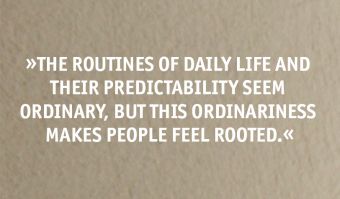
A place of anchorage and distinctiveness
This place feels like home. It generates a sense of the known, it is familiar and comforting, it feels safe and this is a place where I am sheltered and that creates a sense of belonging. It is distinctively itself. It celebrates where it comes from. It acknowledges its past, its heritage, its traditions and core assumptions about who it is. Its multiple identities, its ideas, its visions are etched into its way of life and this is what makes it special and unique. This place explains to itself where it comes from by its history, built fabric and urban design, its rituals, behaviours and activities. The routines of daily life and their predictability seem ordinary, but this ordinariness makes people feel rooted. Ironically, feeling at ease about itself gives this place confidence about where it is going and more relaxed about any changes that may unfold—so it dares to be innovative.
A place of connection and communication
This is a place of relationships, from the incidental to the casual to the deeply profound. You connect and communicate face to face with neighbours, work colleagues, friends, acquaintances and those different from you. You link to the wider world physically and digitally as well as with your past and potential futures.This place is locally bonded. It is at ease with itself and with the wider world. It reaches out. It is relaxed about meshing its diversities. There is seamless connectivity enabled by high quality urban design, good gathering places and possibilities for chance encounter. Its walkability and varied transport modes—internally- and externally-focused—connect beyond the city confines. Its digital infrastructures reach out to virtual worlds stretching out far and wide. It is the hub from which your transactions with the world flow—both those near to you and those afar.
A place of opportunity and ambition
This place fosters open-mindedness. It encourages a culture of curiosity, it provides choices, options and possibilities in our differing phases of life. It has a ‘can do’ attitude. There is an experimental culture and this keeps it flexible and adaptive to emerging circumstances and changes.Some places provide opportunities and others less so, yet this is a place in which to have ambition, ideals and aspiration. It sparks in you the desire to give free rein to your exploratory instinct and to open out. The raw materials of the city create the potential and are embodied in peoples’ creativity, skills and talents as well as its material resources. These are “things” like buildings and also symbols, activities and the repertoire of local products in crafts, manufacturing and services. They are our historical, industrial and artistic assets including architecture, urban landscapes and landmarks as well as our indigenous traditions of public life, festivals, rituals and stories, hobbies, enthusiasms and amateur cultural activities. This draws attention to the distinctive, unique and the special in any place. These resources are all potential opportunities. Acknowledging this can engender a spirit of generosity. It can create the desire to give back to your city. This helps generate civic pride, loyalty and trust.
A place of nurture and nourishment
In this place people can flourish and there are many opportunities to self-improve from the formal to the informal. This is a lifelong learning environment and a place where a culture of discussion is vibrant. This place cares about every aspect of your life. Here you can grow personally and professionally and the city helps you in this endeavour. It reinforces your necessary ladders of opportunity to move forward. It provides accessibility and enables mobility and helps move away constraints. It enables you to be more fulfilled and to widen your horizons. You are fed by these broadening perspectives and so learn and reflect. This can help citizens become more competent and confident and thus willing to participate in helping to shape, make and co-create their evolving city. To make this happen requires preconditions and these include good facilities, be they in education and research, health care, social provision, affordable housing, parks, good retailing and cultural facilities from the large-scale to the intimate. It will provide anything that makes it more liveable. Overriding everything there is a spirit of generosity and of giving back and this in turn inspires citizens to aspire to give of their better self and to become the best they can be.
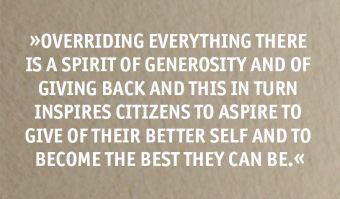
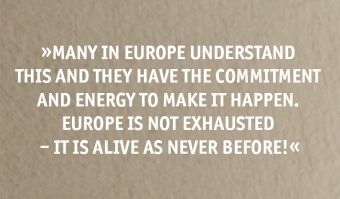
A place of inspiration and imagination
This place has a visionary feel. It lifts you up from the day-to-day. You feel at one with yourself and your city. It provides a heightened level of experience by its beauty, and what that is remains ever debatable—and so it is also a place of possibility and excitement. It allows you to envision what could be. Here, aspiration and good intent is made visible in both the built fabric and through the vitality of its culture and urban programming. Each reinforces the other and this creates a virtuous spiral. This visionary dimension reflects the ideals and ethics that the city wishes to project to its citizens and to the wider world. These greater purposes beyond self-interest change over time.
In bringing about a New Renaissance, three foci are important. First, we need to heal the division between the city and nature in a changing climate; second, we need to be imaginative in working through how we live together with our differences; and third, we need to unleash the creative potential in each one of us.
Many in Europe understand this and they have the commitment and energy to make it happen. Europe is not exhausted – it is alive as never before!
Charles Landry
Charles Landry works with cities around the world to help them make the most of their potential. He is widely acclaimed as a speaker, author, innovator and he facilitates complex urban change projects.His aim is to connect the triad culture, creativity and city making. An international authority on using imagination in creating self-sustaining urban change Charles has advised cities or given talks in over 60 countries. He helps shift how we harness possibilities and resources in reinventing our cities and his Creative City concept has become a global movement. His book The Art of City Making was voted the 2nd best book on cities ever written by the planning website: http://www.planetizen.com/node/66462. His most recent books are The Civic City in a Nomadic World and The Creative Bureaucracy with Margie Caust. The latter has become a movement with an annual festival taking place in autumn every year in Berlin. The 2021 Festival had over 18000 visitors. Other books cover the measurement of urban creativity, the digitized city, urban fragility and risk, the sensory experience cities and interculturalism. For further information: www.charleslandry.com
Picture © Lukas & Joe
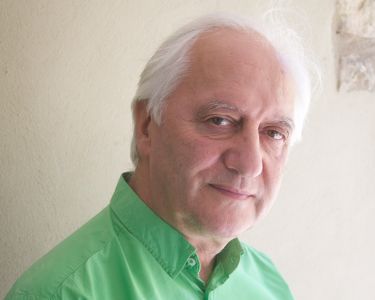

Intellectual Property and the Industry Commons
Industry Commons Foundation
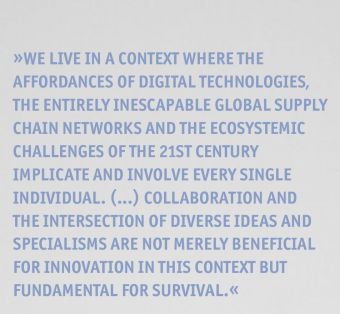
Intellectual Property and the Industry Commons: Unlocking the Renaissance
Recognised as a major influence on economists, Leonard Reed’s 1958 essay ‚I, Pencil’ demonstrated that the invention of even the simplest of objects is the result of mass collaboration. A pencil is made by loggers, graphite miners and factory workers. Its form is predicated on the invention and widespread adoption of writing and drawing, and it requires an ecosystem of other technologies from pads of paper to marketing and distribution networks. The workers involved need to eat food and travel to work, and this all takes place within an elaborate economic and social web.
As interwoven, interdependent, cross-disciplinary and intricate as those systems were, Reed could not have foreseen the world to come. The extent to which the processes, raw materials and interconnected networks would become exponentially and globally more complex sixty or so years later would have been absolutely unthinkable. What had been the paradigm-shifting impact of Reed’s observation now needs to happen again at the next order of magnitude. We live in a context where the affordances of digital technologies, the entirely inescapable global supply chain networks and the ecosystemic challenges of the 21st century implicate and involve every single individual. We can no longer extricate ourselves from those global systems. Collaboration and the intersection of diverse ideas and specialisms are not merely beneficial for innovation in this context but fundamental for survival.
These intertwined framework conditions and cross-domain technological affordances lend themselves to the design of new supporting frameworks that are more inclusive and equitable. For the first time ever, the acceleration of industrial digitalisation provides an opportunity to build radical or disruptive innovation on top of existing intellectual property (IP), in a system that is fully trackable and accountable for all involved. Our tests conducted in the past five years2 demonstrate that ensuring traceability and attribution creates a powerful incentive to share data and other assets across fields, sectors and industries, helping humanity embrace innovation with greater motivation and efficacy than ever before.
Intellectual Property is a broad, complex and discursive area of study, subject to critique as a preventer of innovation and as a barrier to the creation of new ideas. Its fundamental condition as a category of property law has led to its status as a domain of guarded ownership, complicated routes to permission and a punitive legal minefield with steep costs for infringement – intentional or otherwise. The default position for access to industry IP has long been a blanket ‘no’ except under exceptional, usually expensive circumstances.

IP regulation has not followed the evolution of IP value creation.
In his ongoing quest to find out more about how people create and innovate, Professor Brian Uzzi, a professor of leadership at the Kellogg School of Management, Northwestern University, and his team, measured the citations of every paper available in the Web Of Science, a repository of some 30 million scientific papers dating from the early 1900s to the present day.3 The articles with the most significant impact, he discovered, were collaborative. “Since 1950, teams have become more prevalent as a production mechanism,” he said in an interview for the BBC podcast Sideways.4 “Teams are getting bigger over time, [and] they are three to four times more likely to write a hit paper or produce a hit patent than individuals.”
He also noted that these teams were primarily composed of specialists from different disciplines: “Biologists working with economists and anthropologists, or historians working with big data experts and ethnographers.” This meeting of minds across boundaries is known as recombinant innovation, and it has an impressive track record of helping humanity make significant strides forward.
Fear of sharing IP, however, is deeply embedded. Sandra Vengadasalam of the Max Planck Digital Library describes how researchers feel about the issue: “If you ask them ‘What are you afraid of?’ – and it doesn’t matter which discipline – it’s ‘Oh, I’m super afraid to get scooped’.” In other words, there is strong concern that colleagues or competitors will steal a march on you and publish first. “It starts when you want to share your PowerPoint presentation, some pictures of your last microscopic data, whatever,” she continues. “There’s always the fear of ‘Okay, what can I give out? And what about my intellectual property?’”5
In the corporate world, the issue of IP is broad, complex, and carries significant responsibility for erecting barriers to ideas and holding back innovation. Indeed, amongst the closely guarded IP locked away by industry lies a substantial proportion of the estimated $100bn value of data sharing. But this isn’t simply an issue of trust. There can be problems relating to interoperability and conflicting standards, which make sharing difficult, despite the obvious benefits of overcoming them.
Take the example of driverless vehicle data. In 2017, Chris Ballinger, Toyota Research Institute’s CFO and Director of Mobility Services, estimated that it would take ten years for any single company working in the field to collate all the information they need about roads and infrastructure.6 That information is almost instinctively placed under lock and key as it is collected. But if the data is shared between, say, nine other competitors, it could be gathered in a single year, allowing much more rapid progress to market. By pooling information and standardising interoperability, everyone would, metaphorically speaking, be using the same railway tracks.
To increase the value of IP, we need to operate on common railway tracks.
In his book How Innovation Works,7 Matt Ridley lists endeavours for which the free sharing of ideas was pivotal: “…the Dutch East India company’s cargo ship, the Fluyt; Holland’s windmills; Lyons’ silk industry; crop rotation in England; Lancashire’s cotton spinning; America’s engines for steamboats; Viennese furniture; Massachusetts paper makers…” He also notes: “It was the flowering of societies, clubs and mechanics’ institutes that gave Britain its lead in the Industrial Revolution.”
Just as societies and clubs provided meeting grounds and shared points of cultural connection, it is necessary to now share spaces of common understanding with culture as a pivotal element, and creativity as both facilitator and the reason for coming together. For the past decade, MTF Labs has demonstrated that music provides that shared cultural touchpoint, common ground, creative spark and “social glue” that connects otherwise divergent minds.
Music thrives on the melding of diverse perspectives. For instance, the ongoing global success of the Swedish songwriter Max Martin has relied on an extraordinary list of collaborators: death metal artists, classically trained pianists, musicians from Barbados, India and beyond. This has contributed to Sweden being the number one country in the World for music exports per capita.8 Writer and thought-leader Matthew Syed argues that pop music has become the “recombinatorial art form par excellence,” a product of “the constant search for the sweet spot of musical collaboration.”
Crucially, those collaborations are supported by an advanced IP framework, thanks to more than a decade of work by the music industry to develop platform alignment for metadata. That industry is also starting to adopt systems for rights registration at the point of creation, such as Sweden’s Session, now used by Spotify and YouTube,9 which can unlock hundreds more millions of euros in untapped value. The Industry Commons IP Framework Study (2021)10 identified several cross-domain use cases where this kind of approach to IP management is already speeding up time to market. Equally, expanding one’s sphere of influence may uncover unexpected markets. A study of the expansion of the European Open Science Cloud revealed that its FAIR system of data sharing (findable, accessible, interoperable and reusable) turns into a system of data valorisation when deployed by commercial organisations.11
The unlocking of an interoperable Industry Commons of data-driven assets also provides creative innovators with the opportunity to generate new ideas that include intellectual property owned by others. Placing a wealth of existing research, R&D, products, designs and creative works into the hands of creators radically accelerates the innovation process, provides rapid knowledge transfer across domains and carries the potential for cross-sectoral and hybrid projects that could not have taken place within an individual industry vertical or organisation.
Pablo Garcia Tello, Section Head of New Projects and Initiatives at CERN, calls this “The New Alexandria”, inspired by the colossal library of the ancient world, which contained more than 400,000 scrolls and was available to anyone and everyone. Whatever you may take from The New Alexandria, he says, the rule is that you give something back. This would, in his words, “democratise knowledge and innovation while giving credit and recognition to the creators.” Such an innovation ecosystem could, he believes, help to integrate cross-disciplinary innovation and entrepreneurship.
Christer Gustafsson, Professor of Sustainable Management of Cultural Heritage at Uppsala University, believes the innovation that such systems could unlock goes beyond mere economic value: “My focus today is to more-or-less completely change the mindset from starting with this ‘protection oriented’ idea… It could be the change from an industrial society to a post-industrial society.”

IP valorisation is dominated by systemic inequality.
Patenting is still by far the most commonly used system of IP valorisation, even though it still carries the signs of the era that launched it, when married women were not allowed to own any kind of property:
Women do not get a fair share when it comes to patenting and are far less likely to own patents. This disparity is in part because of not only the inherent biases in science and technology and in the patent system itself, but also because of the high costs of even applying for patents. […] Patents are a glaring exception to the unregistered protections provided in other areas of intellectual property, which are more egalitarian in design.12
Currently, European patent granting procedures are expensive, slow (three to five years, on average), burdened with obscure legal terminology and fraught with problems relating to the definition of ideas and similarity to other patents. IP Screener13 makes a powerful case for making all patents findable with AI-assisted technologies, so independent inventors can affordably source and track existing inventions using plain language, build their knowledge from existing inventions and avoid infringing on protected IP.
To the minefield of gender and economic inequality for independent inventors, data-driven systems introduce additional challenges for IP management. Bias inherent in data sets, problems with data provenance verification, and risks of negative impacts on social behaviours have prompted industries to increase the demand for testing of new data-driven industrial applications in low-risk “living labs” environments. This allows them to capture unexpected outcomes from novel applications of frontier technologies before deploying them at scale. The core assets of manufacturing and industrial production have all become digitised, and all industries are now data industries. As data becomes a critical raw material and crossing streams becomes much easier, the risks to widespread bias become all the greater.
Allowing data provenance to remain in the black box presents an enormous risk for society. While this points to a growing need for new regulation and standards for data markets, it also enables new economies and value systems, creating a major new economic paradigm for society. Solving how IP attribution and provenance work in data markets can result in an explosion of new types of innovation, and as data becomes central to every industry vertical, tracking innovation enables unprecedented exploitation of diverse global market segments.
To move the paradigmatic shift of Reed’s “I, Pencil” to the next order of magnitude, a shared commons of trackable, traceable and easily licensable assets must be provided as fuel for a creative and economic renaissance enabled by an explosion of human ingenuity and motivated by the 21st Century’s ecosystemic challenges. We cannot separate ourselves from those ecosystems – or from each other. Whether a pencil, an AI platform, a novel musical instrument or an RNA vaccine, innovation is a major enabler for people to benefit from each other’s contributions. This is what society is for – or should be. It is, therefore, necessary to embrace radical inclusion and stop thinking in terms of ourselves as separate entities with individual characteristics, capabilities and (self-)interests. Instead, let us start with the question: Where do we converge?
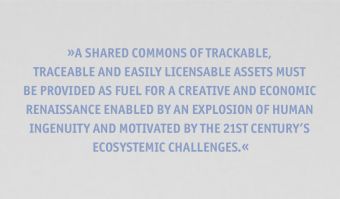
REFERENCES
1 According to Harvard Business School Professor Gary Pisano, incremental innovation for existing competencies and business models is routine; radical innovation builds new competencies for an existing business model; disruptive innovation proposes a new business model for existing competencies; and architectural innovation introduces both new competencies and business models. (Pisano, G. 2019, Creative Construction: the DNA of Sustained Innovation, PublicAffairs).
2 Experiments with creative innovation communities in partnership with blockchain technology companies and other decentralised platforms at MTF Labs in Helsinki, have demonstrated that it’s possible to establish new ways of recording, tracking, and tracing intellectual property live, in real-time, at the point of creation, using distributed ledger technology. These ideas have been codified and scaled up in the Industry Commons IP Framework study (2021).
3 https://insight.kellogg.northwestern.edu/article/science_as_team_sport/
6 Fortune Magazine, 22 May 2017: http://fortune.com/2017/05/22/toyota-mit-blockchain-driverless-cars/
7 Ridley, M., 2020. How Innovation Works: and why it flourishes in freedom, Harper, NY
8 Export Music Sweden, 2020: https://report2020.exms.org/
9 https://musically.com/2021/11/18/rights-data-startup-session-gets-1m-from-spotify-and-youtube/
10 https://industrycommons.net/ip-framework.pdf
12 Marcowitz-Bitton, Miriam; Kaplan, Yotam and Michiko Morris, Emily (2020). Unregistered Patents & Gender Equality. Harvard Journal of Law & Gender.
Michela Magas
Michela Magas is a designer who bridges the worlds of science and art, design and technology, academic research and industry with a track record of over 25 years of innovation. She is innovation advisor to the European Commission and the G7 leaders, member of President von der Leyen’s High Level Round Table for the New European Bauhaus, and member of the Advisory Board of CERN IdeaSquare (ISAB-G). In 2017 she was the first woman from the creative industries to be awarded European Woman Innovator, and in 2016 she was presented with an Innovation Luminary Award for Creative Innovation by the European Commission and Intel Labs Europe. She created the concept of the Industry Commons which has galvanised European industry around cross-domain data interoperability. She is the Founder and CEO of Stockholm-based MTF Labs, a global community platform of around 8000 creative innovators and scientific researchers, which provides a test case for innovation in areas as diverse as neuroscience, forestry and microcomputing. For 20 years she ran Stromatolite Design Lab in London creating design futures with global clients such as Apple, Nike and Nokia.
Picture © Nebojsa Babic square

Andrew Dubber
Andrew Dubber is is an author, academic, public speaker and broadcaster, Director of MTF Labs, and Steering Board Member of the Industry Commons Foundation. He has written extensively on the digital transition, cultural identity in popular music, and social innovation in the cultural sector, including Radio in the Digital Age (Polity, 2013) and Understanding the Music Industries (Sage, 2012). He is the manager of Erasmus+ projects about STEAM education and is an active participant in EU Horizon projects about innovation and the Creative Industries. Until 2015, Dubber was UK Arts and Humanities Research Council Knowledge Transfer Fellow and Professor of Music Industry Innovation at Birmingham City University’s Centre for Media and Cultural Research. As an academic he led and contributed to practice-based research and Knowledge Exchange projects focusing on digital mediation, intellectual property, the creation of meaning from media objects within social and cultural networks, and innovation for social change. As an early adopter of new media platforms, Dubber has been blogging since 2002 and podcasting since 2004.
Picture © Michela Magas
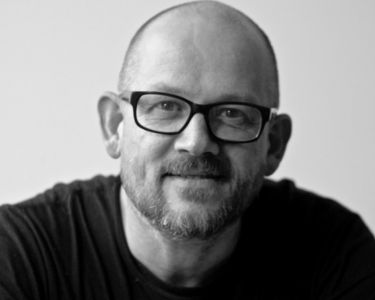
Rhodri Marsden
Rhodri Marsden is a writer and musician based in the UK. He was the technology columnist for The Independent newspaper from 2006 until 2016, and subsequently took on that role for The National, a leading English language paper based in the UAE. His other writing, on subjects ranging from male-pattern baldness to amateur perfume makers, have appeared in dozens of publications including The Guardian, i, Daily Telegraph, New Statesman, The Times, Glamour and Cosmopolitan. His annual fundraising efforts for the homeless every Christmas Eve on Twitter provided the catalyst for his most recent book, A Very British Christmas. A sought-after producer and musical director, he had an unlikely top 20 iTunes hit in 2019 with a disco album on the subject of Brexit, and he continues to perform as part of the much-loved pop group Scritti Politti.
Picture © Laura Ward


The future belongs to the creative
Hamburg Kreativ Gesellschaft

The future belongs to the creative
How companies use the potential of the creative industries to stay innovative
Tesla is not a car manufacturer. Tesla is a software company that also makes cars. The car is one product of many, limits are not set. Tesla founder Elon Musk always thinks in terms of opportunities and possibilities, but never in terms of traditions. And that’s new. These are new realities of life that now pose major challenges for numerous companies, especially when it comes to developing innovations. Because tomorrow’s innovations are at odds with today’s industries. In this piece Hamburg Kreativ Gesellschaft mbH shows how looking into the future of content and creative industries is a tool to improve innovation today—across all industries.
The automotive industry is currently experiencing new realities very accutely, especially as it is in the midst of the biggest transformation process in its history. If we leave aside the most obvious challenge—namely the technical component—from the combustion engine to the emission-free automobile, we see a development whose dimensions should not be underestimated: User behaviour is changing dramatically. Not everyone wants their own car and car-sharing is becoming more and more common. In addition, there is a growing environmental awareness, but also social areas of conflict (for example, available and affordable housing) are displacing the supposed self-evidence of owning a car.
Picture above: Welcome at Play Day Final, Copyright by Laura Müller
Picture left: Demo Prototype, Copyright by Laura Müller
The image of the future
The new mobility—especially in large cities—is creating an acute need for innovation in the industry far beyond the ecological-technological sphere. Thus, data- and content-based business models are becoming a central component of a sustainable business model. For the automotive industry (as for many other industries), it will also be a matter of crossing previous industry boundaries and working in an interdisciplinary manner in order to remain capable of innovation. Above all, however, companies will have to deal more and more intensively with the future. We often still cling to the idea that we can’t determine the future, but that it will be determined. But that may prove to be a mistake. Instead, we will have to create tools and methods to really look ahead. Only in this way will the picture emerge toward which we must work.
In 2019, nextMedia.Hamburg and the Cross Innovation Hub (part of Hamburg Kreativ Gesellschaft mbH) developed Content Foresight, a unique, Europe-wide tool for bringing together different perspectives, different know-how, different inspirations, and also very different creative approaches in a media- and technology-diffuse world. Content Foresight has since proven to be a highly effective method for making reliable predictions for the content industry based on creative input and interdisciplinary collaboration with other industries. Just one example: If autonomous driving becomes established in the medium term, mobility providers in particular will have to become much more involved in other business areas than before. Because when the car drives itself, drivers will have time and space for new forms of occupation, new forms of media use. This, in turn, requires creative and content-related input, i.e., content! And that promises enormous potential for creative and media professionals.
Content Foresight promotes creative innovation work
The Content Foresight innovation program we developed is a tool for testing new applications and future business areas for the content and media industry. Content Foresight is based on the research-proven methods of Strategic Foresight and was adapted and further developed by us for the content industry. Beyond the productive interdisciplinary setting, Content Foresight thrives on impulses, ways of thinking and specific skills of external creative professionals who are included in the innovation process. These professionals come from the different submarkets of the creative industries to form a so-called „pool of creatives“. As part of the project, they are not only paid for their contributions, but also meet the participating companies at eye level and can build a new network. Applicants so far have been people from the various submarkets of the creative industries, with a focus on different digital competencies, i.e. software development, PC games, interaction/UX design, sound, virtual and augmented reality and storytelling.
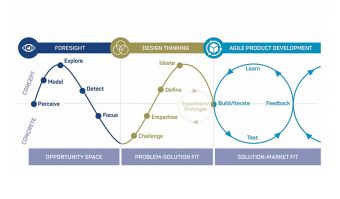
The new renaissance of the creative
The „New Renaissance“ that is emerging now, at the beginning of the 21st century, will have to leave behind the purely growth-oriented, resource-consuming innovations and thus bring about socially desirable changes. The term Renaissance was chosen deliberately because the „old“ Renaissance, i.e. the period between the 14th and 16th centuries, led to a boost in innovation in various areas; it was the time when technology and art, science and creativity merged. We want to build on this—especially in times of the COVID-19 pandemic—in order to contribute to overcoming the crises of our time. Because it is a sector that we hold in high esteem which is becoming the driving force behind this movement: the creative industries. It seems to be the sustainable winner in the merging of all areas of our lives. It is characteristic of the new renaissance that problems and crises can be solved more and more effectively across all areas and sectors. What was once separate, the creative person is able to connect with bridges and lead to innovative solutions. The creative industries are now an innovation-driving sector of the economy that is successfully leading other economic players into the new renaissance.
Picture left: Foresight Process / Copyright: Rohrbeck Heger GmbH
In recent years, the content-producing players in the creative industries—the publishing, media and music sectors, and of course journalism—have been the first sectors to digitise and transform themselves and they continue to do so. This is because the traditional media companies are facing a permanent change in terms of the behaviour and demands of the users of their products and services. Subscriptions are becoming memberships, content providers are becoming curators, and monothematic offerings are becoming lifeworlds and services that must be able to be mapped seamlessly on all platforms. As a result, data-driven business models are moving further into the foreground. Diversified business models must be found to suit the sovereignty, flexibility, and individuality of these users. With the credo of „meeting users where they are“, the industry has had a self-imposed target since the 2010s and continues to be dependent on technology and data, and thus on monopoly-like infrastructure providers, such as platforms, software and hardware providers. One also observes within the content industry an increasing merger of different providers into cooperations, alliances or mergers—and with it an increasing willingness to innovate, indeed an innovative power.
In other words, the content industry has the best prerequisites for the new renaissance.
Picture right: Status Quo, Copyright by Laura Müller

Looking to the future promotes the innovative power of today
In our view, Strategic Foresight is therefore the most suitable method for bringing together areas that are supposedly alien to one another to exchange ideas and find concrete solutions to their current and future challenges. After all, looking into the future promotes innovation today. However, companies still too often face major hurdles in perceiving and exploiting this potential. But simply dealing with a time horizon of five years is still unusual in companies. In order to better cope with the approaching, rapid changes and not only remain capable of acting, but also to be able to shape the future, even more courage and willingness to take risks will be required in the future.
This willingness also includes cooperation across industry and company boundaries. Most industries and management strategies still seem to be unfamiliar with open and cross-innovation processes. Yet the increasing complexity of our world is due not least to the convergence of markets and industries. So while classic competitive thinking can make long-term innovation even more difficult, it is often neutral and supra-organisational approaches that can create new spaces of opportunity and change mindsets. And above all, the involvement of the creative industries creates additional potential. Their ways of thinking and working not only provide new impetus for the innovation process itself, but are also becoming indispensable in view of the need to shape a new, sustainable, equitable future.
Picture below: Michail Paweletz reads 2034, Copyright: Laura Müller
For the practical application of content foresight, we rely on the following approaches:
1. With a cross-innovation approach, we create a setting that is considered to be particularly conducive to innovation and can thus bring two different sectors into innovation work in a targeted manner, in which we work in a user- and solution-oriented manner with the help of methodologically sound processes.
2. The focus is on methods of strategic foresight, which not only look at the development of possible futures, but also specifically enable the identification of so-called opportunity spaces and thus recommendations for action to successfully anticipate them.
3. In the subsequent design thinking process, concrete prototypes are developed alongside the joint visions. In addition, we rely on special impulses in these processes through targeted collaboration with actors from the creative industries.
4. As a public provider, we also act as a neutral player in this process and create trust among the companies involved and, where applicable, among competing companies.
With this setting, in a format that is unique in Europe, we are not only creating an experimental area for concrete approaches to current and future challenges, but also new impulses and foundations for the sustainable innovative capacity of the participating players.

So what do the possible futures look like when actors from the content industry work together with mobility experts? Where are the opportunity spaces? Content Foresight – Mobility by nextMedia.Hamburg and the Cross Innovation Hub produced the following triad of innovations:
Business ideas using the example of the content & mobility interface
I.
2024. For a time horizon of five years, the Hamburger Morgenpost and Schwan Communications have developed a tangible solution for linking content and mobility offers that can already be implemented with current technologies. The prototype Digital Guided Tour /HAM offers users multimedia content (video, audio, text) that functions in a wide variety of means of transportation, is coupled with them, and whose playout is adapted to the means of transportation. In this way, it not only offers content providers new distribution channels, but also creates incentives for the use of public and/or climate-friendly means of transport in the city—from e-scooters to sharing offers and public transport. This applies not only to local residents, but also to the more than seven million tourists who visit the Hanseatic city every year, thanks to the integration of tourist attractions and historical content.
II.
2029. The project team of MaibornWolff and pilot Hamburg planned the next step: With S.T.E.P—the Seamless Travel Experience Platform—mobility and entertainment/information are individually tailored to the user. Instead of having to actively choose from countless options how to get from A to B and which content can be consumed on the way, a digital twin creates situationally optimal decision bases for seamless travel planning. The blockchain-based application already developed promises all-in-one processing. In a planning horizon of about five to 10 years, app chaos on smartphones will then be as much a thing of the past as login madness. Through a public-private ownership model, in which the public sector acts as a regulator, a critical mass of services and users* can be aggregated, which can fully keep an eye on the optimisation of passenger transport, independent of the economic success of individual providers.
III.
2034. What’s next? How do we envision mobility and content when blockchain technologies and AI-supported systems have long since become part of our everyday lives and our data precedes our decisions? Representatives from NDR, Axel Springer, HOCHBAHN, IAV, ITS Hamburg 2021 and Wunder Mobility give us an impression of this in their concept of experiential mobility. In the sense of a pre-prototype, the team developed a vision of mobility in a time horizon of about 15 years, which considers social (e.g. environmental protection, education), political (e.g. data sovereignty), technological (e.g. autonomous driving, artificial intelligence as technology serving people, digital identity) and individual aspects (e.g. consumption, convenience) in equal measure and integrates them into product and service scenarios.
The vision, spoken by ARD news anchor Michail Paweletz, is publicly available here.
Open even to unfamiliar input
So… You can’t do it without looking into the future. But… Everyone looks at the future differently. To find the best solution together, it is crucial to organise an exchange—and to learn from each other. This is the only way to create innovations.
If you want to be innovative tomorrow, you have to be open today, even for unusual input—and above all for new content!
Quotes from company representatives:
Dr. Johanna Leuschen, Head of NDR Audio Lab (Norddeutscher Rundfunk)
„We believe that in the future we will always get the content that is best suited to our mood, in the current mobility situation, in the time available. The keyword here is personalisation. The user focus is and will remain essential. For journalism, AI could be useful in an assisting role: Tasks that do not necessarily require creativity (weather, election or sports results) could be taken over by algorithms. Then journalists could devote themselves entirely to creative and research-intensive topics. And we assume that companies in general, not just content providers, should look at an audio and voice strategy and tailor their offerings for a voice-driven world in the long term. Discoverability is going to be a big challenge going forward.“
Nicolas Meibohm, Head of Connected Car (Axel Springer SE)
„We often still cling to the idea that we can’t determine the future, it will be determined. But that is exactly the mistake. So now, once we really look ahead, we get a picture we can work toward. This program has set a benchmark and proven that interdisciplinary collaboration really makes sense.“
Hendrik Menz, ehemals Director Business Development (pilot Screentime GmbH)
„It takes a wide range of relevant expertise and value-added fields to absorb the necessary complexity of a holistic approach.“
Dr.Nina Klaß
Dr. Nina Klaß is an expert in content and tech innovation. She leads nextMedia.Hamburg (part of Hamburg Kreativ Gesellschaft mbH) where she developed and executed a range of highly recognized innovation programs such as the Content Foresight project. Previously, she was head of digital product marketing & sales management at SPIEGEL Group. She is active as funding committee member, jury and advisor of innovation programs worldwide.
Picture © Oliver Reetz

Egbert Rühl
Egbert Rühl has been active as a cultural and arts facilitator his whole life – in many different genres and functions. He is the managing director of the Hamburg Kreativ Gesellschaft. In this role, he is responsible for strategy and tactics, guidance and moderation, budget compliance, and contact with politics and administration.
Picture © Oliver Reetz

Marc Eppler
Marc Eppler is responsible for nextMedia.Hamburg’s partner management and he operates programs such as Content Foresight. Previously, he worked at the Franco-German culture channel ARTE in Strasbourg.
Picture © Oliver Reetz
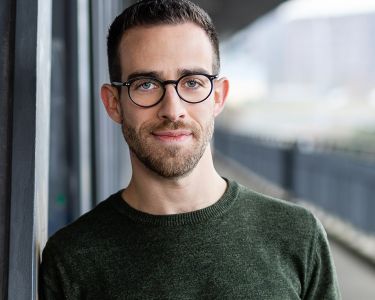

Space race for the people
Director of the European Cultural Foundation, Amsterdam

Space race for the people
A call for a European Public Space Programme
Europe needs a Space Programme. But instead of racing to outer space, as seems fashionable among global powers and private zillionaires, Europe’s Space Programme should be earthbound and race to reach the people of Europe. Creating a functioning European public space will not only fire up all sorts of technological innovation but most importantly strengthen a European sense of belonging, a European society of sharing and enable a 21st-Century Renaissance.
We are living through pandemic times. As well as Covid-19, there is a climate pandemic, a pandemic of inequality, a pandemic of polarisation. These individual pandemics are interconnected and together they are creating unpredictable dynamics. There is no way back to a normality which had already become increasingly self-destructive.
Human history has shown that crises can also be times of opportunity, creativity and invention. The 14th to 16th centuries were times of brutal power struggle, never-ending wars, Black Death and misery. But they also unleashed a movement of radical transformation, discovery and beauty, the first European Renaissance. Can our times unleash a similar creative boost? Can our times give birth to a 21st-Century Renaissance? Future generations will be able to tell. Our job is to make it happen.
Here is one element which I consider vital for the next European Renaissance to succeed.
Our public and civic spaces are shrinking, more restricted, more segregated, more commercial and covered in advertising. When governments turn autocratic, public spaces are especially vulnerable to mass surveillance abuse and manipulation.
The European public space is nascent. Where it exists, art and culture have been its forerunners. Look at the range of European orchestras, festivals, exhibitions, pop culture and architecture, Eurovision and the Champions League.

National filter bubbles
What do I mean by public space, anyway? Isn’t this just another abstract European buzzword? Well, yes and no. Yes, we should not waste time on hot air that distracts from real issues. And no, because we often fail to find common European answers to common European problems because we don’t have an effective space and mechanism for working things out. Maybe the Brussels bubble does, but the European public doesn’t—and that’s no longer good enough.
Our awareness of what’s going on around us is still largely determined by our national context and reality. We are still trapped in national filter bubbles. We adopt a national perspective on European issues such as pandemic responses, migration, the Euro, data security, energy, climate crisis, unemployment and tax evasion, seeing them in terms of national actors and national interests. But what would the solution to the European debt crisis have looked like if we had dealt with it through a truly European lens? Might the Germans have called for a European approach to refugee policy, not only when refugees arrived in Germany but already years earlier when Greece and Italy struggled to cope with rising numbers of boat people, had they taken a more European perspective to begin with? Could Victor Orban’s wacky conspiracy theories have gained so much traction if the Hungarian people had been part of a truly European public space and independent European media space?
A structural problem
Digital technology is making this challenge even greater. The internet could be a space for global enlightenment, but instead it risks becoming an anti-Enlightenment echo chamber. The digital filter bubble is narrowing our horizons to our own social media environment and likes. Those who understand how to play the filter bubble game best win attention, market share and elections.
The digital European public space has been colonised by non-European private platforms with little regard for democratic values and privacy standards. They have profited massively—and still do—from the systematic exploitation of European data, without paying their fair share for European content and for extracting billions and billions of Euros from European users while free-riding the European digital space. A genuine European public space is of little interest to the click-economy apart from data mining and maximising advertising revenue.
At the same time, the business model of quality journalism is being eroded. This is becoming a systemic risk for Europe and a threat to democracy at large.
In addition, in some EU countries even the national public space is coming under pressure: If media pluralism and independence are disappearing in places like Poland and Hungary, this has a direct effect on the whole way in which the EU operates and sets standards, or not.
Hence it is not surprising that we lack a shared understanding of problems and opportunities, let alone on finding genuine European solutions. In the long run, our European community, our European Democracy will flourish only if supported and controlled by a functioning European public space rather than fragmented national ones.

What to do?
We need a European Space Programme, a public space programme that connects people and is meaningful, safe, open for creative opportunities and inclusive. We need to invest in a European public space that offers a framework for togetherness, for exchange, for real European communication, for us all and not just for a select few. This task cannot be left to the invisible hand of the market, or be surrendered to operators like Meta/Facebook, Starbucks and Alibaba. This is about identity, democracy, and the future of the European model.
The European Space Programme must guarantee freedom of speech and maintain diversity without becoming mired in bureaucracy. It must not become a propaganda tool for the European Union in any way and must be subject to clear and credible governance.
This Space programme should support all formats which create a European public space, digital, analogue, as well as innovative combinations of the two. This includes European media, European social media platforms, games, but also festivals and events like Eurovision, awards, library networks and all kinds of other things we can scarcely dream of today.
The multilingual advantage
The killer app will be a solution to the language challenge. The EU has 24 official languages and a whole lot of semi-official ones. This makes it naturally more difficult to create a public space than in a community with only one language. Europe should take on this challenge proactively by exploiting the rapid development of digital translation technology. Serious investment in a multilingual public space will have spillover effects into other areas of our societies, and could be a key element of Europe’s innovation policy.

Show me the money
Space programmes cost money. We should be prepared to spend a multitude on a functioning, fair and inclusive public space on earth rather than spending on reaching outer space. Apart from sufficient funding, a successful initiative for a European public space will require a balanced mix of good governance, appealing formats, effective distribution channels, cutting edge language technology and fair regulation. What sounds quite straightforward will indeed mean squaring the circle, or put more optimistically, will be one of Europe’s most exciting and innovative ventures for the next decades—no less than a European Space Programme.
Much of the money needed could come from fees on big digital platforms like Facebook, Google and Twitter. This fee for platform providers will be part of financing the European public space and enable the currently dominant digital platforms that are already profiting from a borderless Europe to contribute to a functioning and healthy European public space. Protecting people’s personal data, and minimising the amount of advertising they are exposed to, can and should be a competitive advantage and a must for the European public space.
Creating a European Public Space is a big task. But there is a lot at stake: identity, democracy, freedom and the future of the European model. Over the past years, we have had many opportunities to see what can happen when civic public spaces are neglected and taken over by post-factual filter bubbles. That is why we need to invest in a European Space Programme to power up the Next European Renaissance.
André Wilkens
André Wilkens is the director of the European Cultural Foundation in Amsterdam which mission is to grow a European sentiment and in response to the Covid19 crisis has launched the Culture of Solidarity Initiative. André is also the Board Chair of Tactical Tech, the co-founder of the Initiative Offene Gesellschaft and a founding member of the European Council on Foreign Relations. In the past he worked as Strategy Director of Stiftung Mercator, as Director of the Open Society Institute Brussels and as Head of Strategic Communications of UNHCR in Geneva. André is the author of two books, on Europe (Der diskrete Charme der Bürokratie, S.Fischer 2017) and on Digitalisation (Analog ist das neue Bio, Metrolit 2015), and a regular media contributor.
Picture © Gerlind Klemens

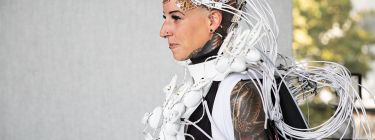
Innovation Through Universitas
Vice Rectorate for Innovation & Researchers at Johannes Kepler Universität, Linz
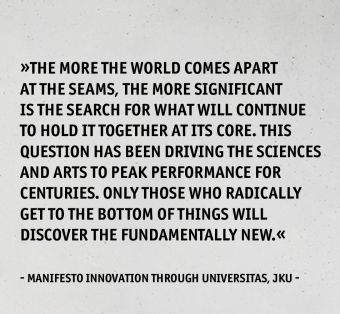
Innovation Through Universitas
The complexity and urgency of current conflict areas poses major challenges for us as a society. Digital and environmental changes are confronting us with a range of unknowns, fundamentally re-sorting our world, and doing so at an enormous speed. Automation and artificial intelligence are permeating the entire economic system, raising fundamental questions, fundamentally changing our everyday lives, and redefining human work. The consequences of global warming, from hurricanes and floods to glacier melt, are pervasive, devastating, and express the need for rapid action. The European Commission’s current work program (2021) not only puts „twin green and digital transitions“ at the top of the political agenda, but also emphasises the close intertwining of green and digital transformation. In this context, it is more important than ever to focus on their interdependencies. The Covid-19 pandemic recently showed how interdependent and interrelated everything is and how highly interconnected our world is. In a short period of time, the virus held the entire world in thrall, had an impact on all areas of our society and required cooperation across borders, institutions and disciplines.
The complexity of these challenges and the multidimensionality of networked systems require the dovetailing of different working methods, perspectives and approaches from science, business, politics, society and art. Only by entering into these synergies beyond one’s own institution, with other scientific disciplines and the integration of different actors, can novel and sustainable solutions be found. This results in a systemic change on all levels of our society. The relevance, potentials and possible practices will be elaborated in this paper using the example of higher education and the re-interweaving of art and science.
While art and science were once closely interwoven and mutually stimulating sources for the creation of something entirely new, with the end of the Renaissance they were steered in separate directions. In order to cope with the ever-increasing wealth of knowledge, the disciplines became detached from one another, leading to a high degree of specialisation and the fragmentation of knowledge.
This liaison between art and science needs to be re-established and strengthened in light of the need for innovative solutions and pressing societal and social issues. The pursuit of new knowledge and the search for solutions in the unknown have always been the driver and motor of both science and the arts.
„The analogical spirit is not only a matter of art, but also of science. May the criteria be different, artistic and scientific creativity have this in common, that it is about discovering, uncovering, endowing, or visualizing connections.“ (Gabriel 2017, p. 194)
Creative thinking, which in science as in art has led to new insights and discoveries is, as Gottfried Gabriel states, a unifying element. This makes it possible to recognise connections and to combine the familiar in new ways. As some well-known examples from the history of science show, it was often a creative idea that led to the formation of a new hypothesis, the subsequent verification of which brought the long-awaited solution to a problem. Expertise and methods for testing the hypothesis are essential. However, discovering, inventing and finding something truly new also requires creativity, which makes it possible to lead in a detached way beyond the limits of the possible.
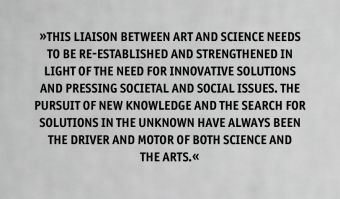
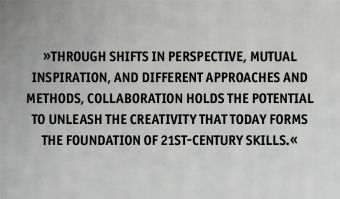
Alexander von Humboldt’s educational ideal and ideas about the university („universitas litterarum“ = „community of the sciences“) are based on holistic education in the arts and sciences and are becoming increasingly important due to current developments. Through their inherent creativity, imagination as well as execution and testing of new ideas, art and science are connected more than is generally assumed. Both are accustomed to navigating through uncharted terrain, do not shy away from complex problems, and, by exploring and creating the radically new, are the source and impetus of innovation in our society. Through shifts in perspective, mutual inspiration, and different approaches and methods, collaboration holds the potential to unleash the creativity that today forms the foundation of 21st-century skills. It is essential to focus not only on interdisciplinarity but above all on transdisciplinarity in education and research so that we do not run the risk of losing sight of the interrelationships in view of the high degree of specialisation on the one hand, and on the other hand so that new ideas can be brought into the world through mutual inspiration.
“By seeing the big picture—the interrelationships of knowledge that liberal arts offer—workers of the future can be fluid enough to adapt to changes beyond their individual control.” (Needle et al. 2007, S. 114)
This change is also clearly manifested in the change in the types of tasks occurring in the workplace. Since the 1970s, a steady increase in „non-routine analytical tasks“ and „non-routine interpersonal tasks“ can be recorded, as stated in the current OECD report. In light of the digital revolution, which is drawing a new profile of activities, „education systems must also undergo transformative change.“ (OECD 2020) The study „The Future of Employment: How susceptible are jobs to computerisation?“ by Frey and Osborn of Oxford University also caused a stir, predicting that some 47 percent of U.S. workers will be at risk. (Frey and Osborne 2013) In the study „Solving future skills Challenges“ (Universities UK 2018), the World Economic Forum and the OECD are united by the prediction that digital transformation will have a significant impact on many areas of our lives. In order to respond to these new conditions and remain capable of acting, there is a consensus that new skills will be needed, the teaching of which has been pushed too little or hardly at all to date.
“At the same time, technological change and shifts in job roles and occupational structures are transforming the demand for skills at a faster pace than ever before. Therefore, imperative for achieving such a positive vision of the future of jobs will be an economic and societal move by governments, businesses and individuals towards agile lifelong learning, as well as inclusive strategies and programmes for skills retraining and upgrading across the entire occupational spectrum. Technology-related and non-cognitive soft skills are becoming increasingly more important in tandem, and there are significant opportunities for innovative and creative multistakeholder partnerships of governments, industry employers, education providers and others to experiment and invest in new types of education and training provision that will be most useful to individuals in this new labour market context.” (World Economic Forum 2018, S. 22)
In order to prepare young people for the future world of work—the characteristics of which we can only guess at today—educational institutions have a central role and responsibility. New competencies will become necessary and require a rethinking of our knowledge transfer, learning and training opportunities and research. The rapid development of alternative models and approaches is therefore urgently needed. In addition to the acquisition of sound technical as well as broad contextual knowledge, the training of creative, social and communicative skills is central. The competence to apply this knowledge in different situations is the key to solve complex problems. Only through the power of creativity, „out of the box“ thinking, practical work and an interdisciplinary approach can entirely new ideas and approaches to solving complex problems be developed.
In the TRANSFORM project, this objective finds its first prototypical approaches. In a cooperative effort between Johannes Kepler University, the University of Applied Arts Vienna, Danube University Krems and Ars Electronica, new approaches to research and university teaching are being explored and tested. The development of future-oriented, transdisciplinary and inter-university teaching forms and formats is at the centre of the project.
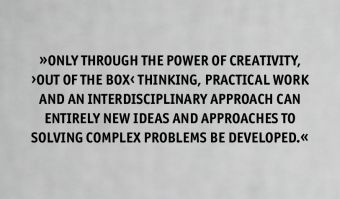
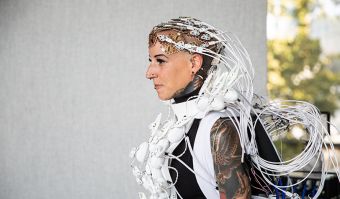
The Pangolin Scales shows how new, groundbreaking inventions can be created through the collaboration of art and science. The work was realised as part of the LIT Special Call Ars Electronica of the Johannes Kepler University Linz in 2020. The call promotes the shaping of innovative ideas through the collaboration of science and art. The Pangolin Scales features an extraordinary scale dress that moves and interacts with its environment, controlled solely by the wearer’s power of thought. This is made technically possible by a world-first, 1,024-channel brain-computer interface (BCI) that is capable of extracting information from the human brain with unprecedented resolution. It was developed by researchers at JKU’s Institute of Integrated Circuits and brain-computer interface experts at g.tec medical engineering GmbH. The impetus and inspiration for the project was provided by fashion tech designer Anouk Wipprecht, who also participated in the development. The LIT Special Call Ars Electronica Festival has been held annually since 2020.
Photo: The Pangolin Scales / Thomas Faseth (AT), Harald Pretl (AT), Christoph Guger (AT), Anouk Wipprecht (NL)
This project is part of LIT-Projects, JKU Campus. The Pangolin Scales demonstrates the world’s first 1.024 channel brain-computer interface (BCI), which is able to extract information from the human brain with an unprecedented resolution to control an interactive, fashionable dress. For further information please visit: https://ars.electronica.art/keplersgardens/en/the-pangolin-scales/
Copyright Information: Tom Mesic
Harnessing the potential of art in reshaping the European economy, in line with the goals formulated in the EU Green Deal and New European Bauhaus, is the central concern of the 12 S+T+ARTS residencies planned for 2021/22. Together with external experts from science, society, politics and business, artists will be invited to act as catalysts for change and develop concepts for a sustainable future.
As a creator of new ideas, a mediator between science and society, and a facilitator of creative, social and communicative skills, art holds enormous potential for research and education. In view of current fields of action, a closing of ranks between science and art is urgently needed, and the potential that their entanglement holds must be exploited.
References
TRANSFORM – Digital and Social Transformation through New Directions in Research and University Education is a cooperative project of Johannes Kepler University Linz, University of Applied Arts Vienna, Danube University Krems and Ars Electronica, financially enabled by the Austrian Federal Ministry of Education, Science and Research.
Zur Website
Manifest Innovation durch Universitas – written by Johannes Kepler University and the University of Applied Arts
See here: www.jku.at/en/manifest
The Pangolin Scales (2020)
Information & Videos at: Ars Electronica Festival 2020; Institutswebsite
All LIT Specialcall Ars Electronica Projects 2020: https://www.jku.at/ars-electronica-2020-in-keplers-garden/
All LIT Specialcall Ars Electronica Projects 2021: https://www.jku.at/ars-electronica-2021-a-new-digital-deal/
S+T+ARTS Regional Centres | Repairing the Present (2021/22)
The Johannes Kepler University is a scientific partner in the Challenge nº2: Circular Futures.
Sources
European Commission (2021): Commission work programme 2022. Making Europe stronger together.
Online at: https://ec.europa.eu/info/sites/default/files/cwp2022_en.pdf
Frey, Carl Benedikt; Osborne, Michael (2013): The Future of Employment: How susceptible are jobs to computerisation?
In: Oxford Martin School, 01.09.2013. Online at: https://www.oxfordmartin.ox.ac.uk/publications/the-future-of-employment/, zuletzt geprüft am 04.11.2020.
Gabriel, Gottfried (2017): Kreativität und Interdisziplinarität in den Wissenschaften.
In: Hanna Kauhaus und Norbert Krause (Hg.): Fundiert forschen. Wissenschaftliche Bildung für Promovierende und Postdocs. Wiesbaden: Springer VS, S. 191–201.
Needle, Andrew; Corbo, Christopher; Wong, Denise; Greenfeder, Gary; Raths, Linda; Fulop, Zoltan (2007): Combining Art And Science In „Arts and Sciences“ Education. In: College Teaching 55 (3), S. 114–120.
OECD (Hg.) (2020): OECD Lernkompass 2030 OECD-Projekt Future of Education and Skills 2030 – Rahmenkonzept des Lernens. Unter Mitarbeit von Bertelsmann Stiftung, Deutsche Telekom Stiftung, Education Y e.V., Global Goals Curriculum e.V., Siemens Stiftung.
Universities UK (2018): Solving future skills challenges.
Online at: https://dera.ioe.ac.uk/32069/1/solving-future-skills-challenges.pdf.
World Economic Forum (2018): The Future of Jobs Report 2018.
Online at: https://www3.weforum.org/docs/WEF_Future_of_Jobs_2018.pdf.
Kerstin Pell
Kerstin Pell works at the Vice Rector for Innovation and Researchers* at JKU and coordinates projects at the interface between art and science. She is responsible for the project „TRANSFORM – Digital and Social Transformation through New Paths in Research and University Education“ in cooperation with the University of Applied Arts Vienna and the Danube University Krems. Before that she worked in the educational and cultural sector.
Picture © JKU / Florian Voggeneder

Christopher Lindinger
Christopher Lindinger has been concerned with the social impact of new technologies and the associated cultures of innovation for more than two decades. He is considered a founding member of the Ars Electronica Futurelab and was responsible for R&D activities as co-director of the lab. Since 2019, he has been Vice Rector for Innovation and Researchers* at JKU.
Picture © JKU / Florian Voggeneder
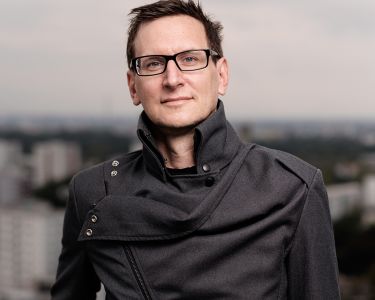

Plea for a European Renaissance from Below
Founders of Herr & Speer, Berlin
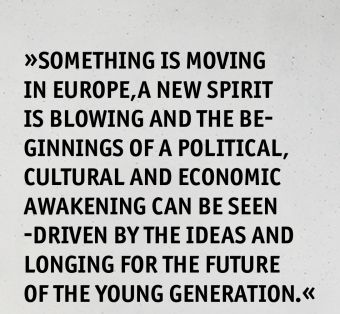
Plea for a European Renaissance from Below
Anyone looking at Europe today sees a continent struggling for its future. We have no doubt that the EU is no longer a stable house: Nationalist and populist movements are undermining Europe’s democracy, civil liberties and the rule of law are in danger, and many citizens‘ fears of decline and worries about the future are real. Instead of 28 states, there are now only 27 united under the umbrella of the European Union. And hanging over everything is the sword of Damocles of the climate crisis with its existential threat to future generations and to our fellow creatures. These and many other concerns are not easy to address and are even more difficult to solve.
But if you look at Europe today, you see not only shadows but also a lot of light. We see developments that give us courage and optimism. Civil society is resisting cuts to the rule of law, tens of thousands of young people are taking to the streets in support of better climate policy, and a new generation of politicians is taking up positions in parliaments and city councils with pro-European ideas and concrete commitment. At the same time, European entrepreneurs and cultural workers are developing solutions and offers that combine economy and socio-ecological responsibility, culture and politics. And all of this is increasingly happening across borders. Something is moving in Europe, a new spirit is blowing and the beginnings of a political, cultural and economic awakening can be seen—driven by the ideas and longing for the future of the young generation.
Rediscovering the Revolutionary Spirit of European Unification
In order for this tender seedling of European awakening, creativity, entrepreneurial spirit, political responsibility and the common good to develop, Europe will need the courage to try something new. Inspiration for this can also be found in the past. The European unification project itself shows with its development steps, which reconciled states and people and gave room to new ideas and methods, how it can be done. This spirit must be rediscovered, just as in the Renaissance, when people rediscovered what was once possible.
If we look at the history of European unification, it is nothing less than a revolution and one of the most successful ventures in history. European unification with its various stages of development—the Coal and Steel Community, the European Economic Community, the European Community up to today’s EU—has fundamentally changed the dynamics of European politics and its modus operandi from what was the continental custom for centuries: rivalry and war.
The result: never has there been a longer period of peace on the continent, never has economic and social progress been so comprehensive. Today, despite all the challenges, the EU is one of the most peaceful regions in the world, as the Global Peace Index shows. This idea would hardly have been conceivable in 1918 or 1945, or even between 1618 and 1871. In terms of peace, the revolution delivered what it promised. This was also due to the fact that this European Revolution was one of a special kind. Unlike many other revolutions with disruptive violent outbursts, political radicalisation and hasty throws, European unification was a process of careful steps, not too big, but mostly consistent.
Against the background of decades of enmity, especially between Germany and France who were central figures in the European project from the beginning, this mode is not surprising. But it has also been astonishingly successful. Traditional and nationally focused politics were not broken up and overthrown in one fell swoop, but reformed in small bites and introduced to a new Europe of cross-border cooperation. This was also due to the courage to come up with new and unusual ideas and proposals.
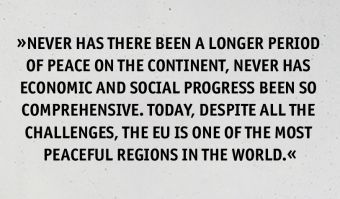
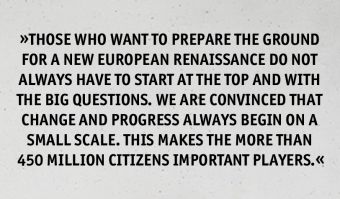
Ideas are the fuel
The EU embodies the courage to give new ideas a space and a chance, even and especially when the deceptive promise of settling down and staying put is at its greatest. This special spirit that can blow when we dare to do something new is described by Gerhard Brunn when the new Commission President Jacques Delors took office in 1985: „From the very first moment, he instilled new self-confidence into the demoralised, disoriented Commission and, with a handful of brilliant staff and a fireworks display of ideas, got it moving in such a way that some people lost their hearing and sight.“ Even if all these ideas (from Delors and many others) were not always implemented immediately, they often came to fruition via detours, and sometimes years later. Whether in the case of the common currency, the dismantling of border controls or a common security policy, a moment has always been found to take a further step toward integration.
In this way, revolutionary things were created through a gradual but constant evolution of political ideas. We call this modus operandi of the European Union and its predecessor organisations the European revolution of small steps. We think it is time to recall this revolutionary spirit, to revive it and to activate it, specifically for the future. While grand and long-term visions and castles of thought are important and can be beacons for the future, the immediate future of Europe is in the hands of those who understand and walk the fine line between too little and too much.
The EU thrives on constant development and movement forward. So pausing is not an option. At the same time, the history of European unification teaches us that taking too big a leap or doing too much in one fell swoop can be equally damaging and counterproductive. The United States of Europe, the European Federation or the European Republic may be inspiring goals, but the way to get there is through concrete, bold and feasible steps that directly and positively improve life in the EU.
Those who want to prepare the ground for a new European Renaissance do not always have to start at the top and with the big questions. We are convinced that change and progress always begin on a small scale. This makes the more than 450 million citizens important players. They help decide the direction in which Europe is heading. But far too often, obstacles are placed in the way of their ideas and their drive, or they are unable to realise their potential for financial reasons. If you want to think about the future, you have to be able to afford it. We have a proposal to change that and give more people the opportunity to drive social, cultural and economic innovation.
A start-up booster for all Europeans as a seedbed for innovation and progress
Europe is not a continent with a strong culture of entrepreneurship or innovation. This is particularly noticeable for young, creative and creative people with ideas. Anyone with an idea for a social innovation, an art project or a company is often confronted with skepticism, risk aversion and complicated access to financial support. Culturally and structurally, the European region tends to be geared more toward security and stability and less toward risk-taking and the ability to change. Anyone in the EU who has run a start-up into the ground or failed with a political idea or an ambitious art project rarely receives recognition or is encouraged to try again. Avoiding mistakes is more important than learning from them.
The European start-up scene is also underfunded. Nearly half of young European companies receive the all-important initial investment from outside the EU. „European investors are cautious and skeptical and want to see sales before they invest,“ writes journalist Grace Brennan. All of this puts the brakes on innovation. It’s no surprise, then, that in the top 10 rankings of the world’s most startup-friendly countries, with the exception of Germany in second place, EU states find themselves at the bottom of the list, in this order: Poland, Spain, Sweden and France. How many good ideas, groundbreaking works of art, smart products or innovative political approaches do not therefore see the light of day?
5,000 euros for all young people as a nationwide start-up booster
If Europe wants to put wind under the wings of the next generation with their ideas and see innovations take off, something has to change. While it takes time and perseverance to evolve cultural behaviours and thought patterns, it is possible to make direct changes in terms of funding and framework conditions.
We propose that every young person in the EU between the ages of 20 and 30 should have access to a so-called European innovation start-up credit. A minimum sum of 5,000 euros should be accessible to all those who want to start their own business with an entrepreneurial idea or a social, cultural or political innovation, or who want to continue their professional training. The sum would be provided by the EU budget from EU taxes and distributed by national and regional employment agencies and offices. Young people could register there or online with their business idea or educational project and thus receive their start-up credit with as little bureaucracy as possible. After a brief check, the funding amount of 5,000 euros would then transferred to the business account or directly to the respective educational institution. A one-time higher funding sum of up to 30,000 euros would also be possible if a convincing concept were presented and appropriate follow-up documentation ensured.
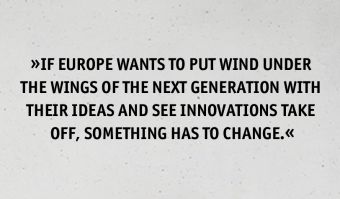
The start-up credit would pay particular attention to an aspect that is often neglected in the discussion about start-ups and innovations: the connection between a successful start-up and the socio-economic background of the founders.
Unfortunately, it is still disproportionately men who found companies. Around 93 percent of tech funding goes to all-male teams.1 So it’s not so much the individual’s dedication, sincerity or courage that determines entrepreneurial success in the early hours, but their financial and social background and gender.2
Those with a safety net can take greater risks. Those who are hyper-masculine take success home with them. The EU must counter this Anglo-Saxon and male-dominated logic and culture with something of its own and respond with an egalitarian, decentralised and diversity-oriented instrument. A European innovation starter credit will change hundreds of thousands of lives and make ideas fly in Europe.
Europe Bottom-Up as an Opportunity
What can happen when millions of people are given the opportunities to test or even implement their ideas and creativity can only be imagined. We are firmly convinced: Europe still has its best days ahead of it if we remember our strengths and values, carefully nurture our curiosity and ability to learn, and empower more people to be part of the path of progress. We, the citizens of Europe, have all the qualities and skills needed for this European path, this new European Renaissance.
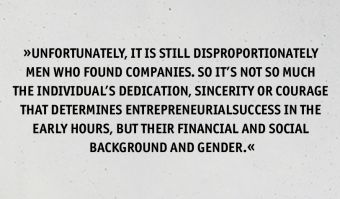
Sources
1 Elizabeth Schulze, »93 % of funding for European tech start-ups goes to all male teams, new report finds«,
CNBC, 07.12.2018, https://www.cnbc.com/2018/12/07/ metoo-in-europe-93percent-of-tech-funding-goes-to-all-male-founders.html
2 Aimee Groth, »Entrepreneurs don’t have a special gene for risk – they come from families with money«,
Quartz, 17.07.2015, https://qz.com/455109/entrepreneurs- dont-have-a-special-gene-for-risk-they-come-from-families-with-money/
Vincent-Immanuel Herr & Martin Speer
Vincent-Immanuel Herr and Martin Speer are authors, speakers and consultants from Berlin. They are initiators of the EU mobility program DiscoverEU and are committed to a united Europe and gender equality. Their latest book „Europe For Future – 95 Theses that Save Europe“ was published by Droemer in 2021.
More info: www.herrundspeer.eu
Picture: © Phil Dera
